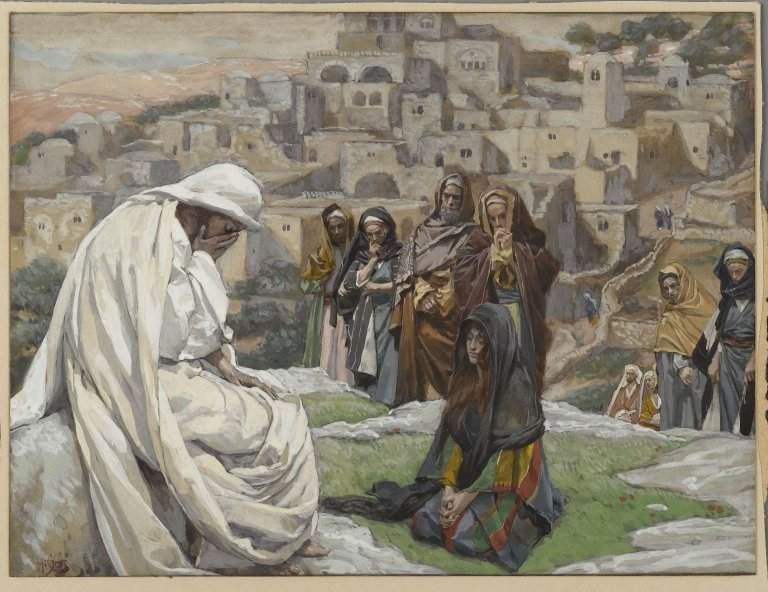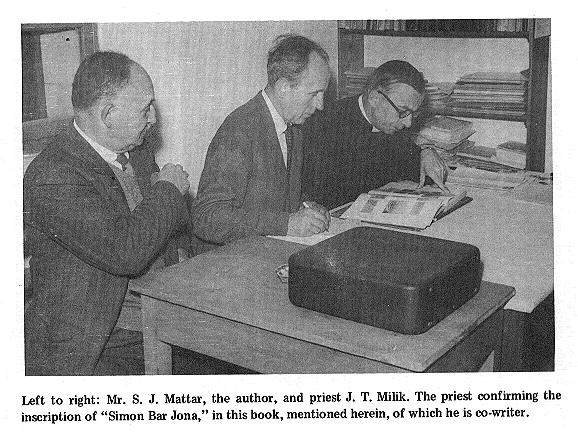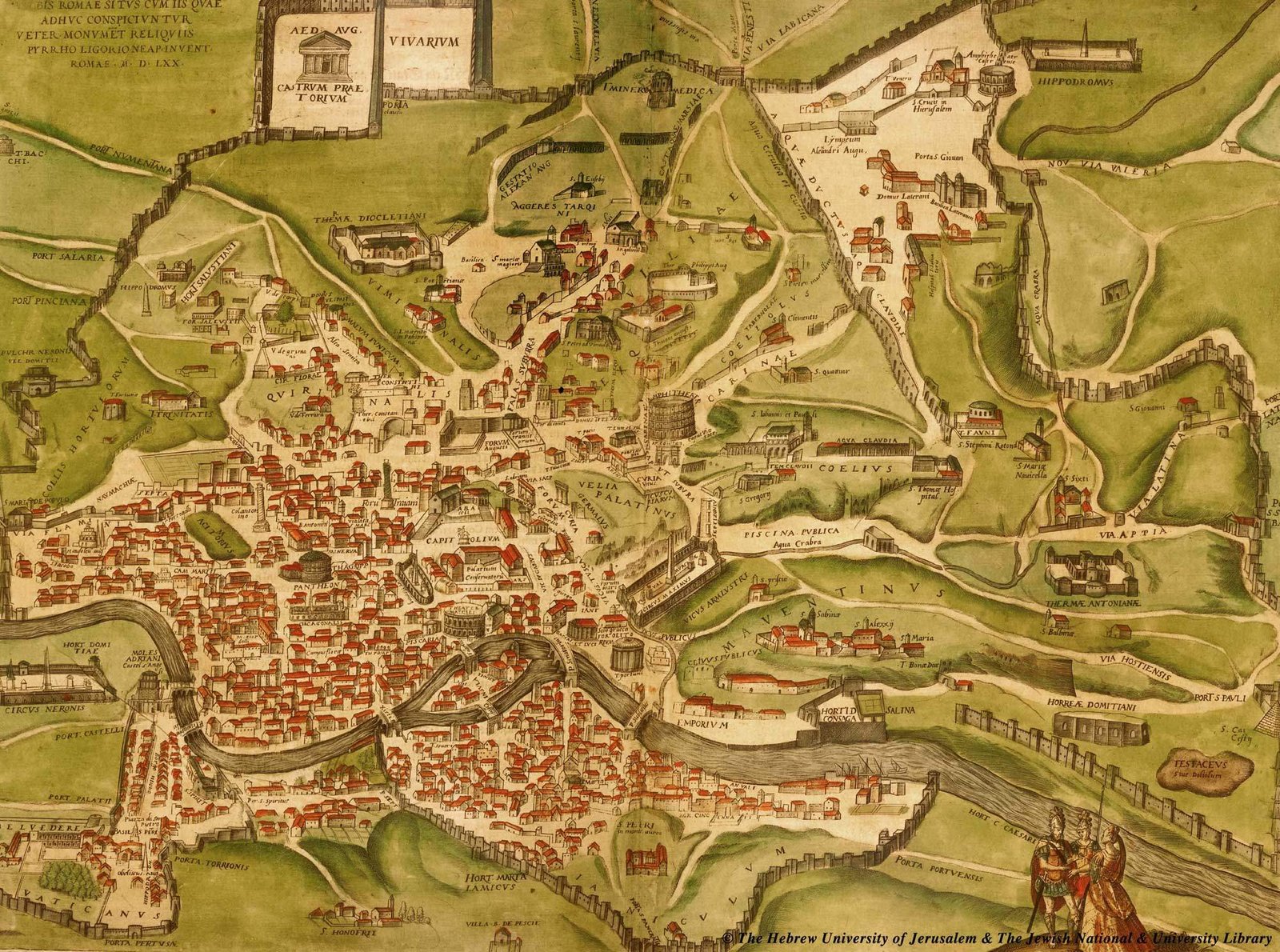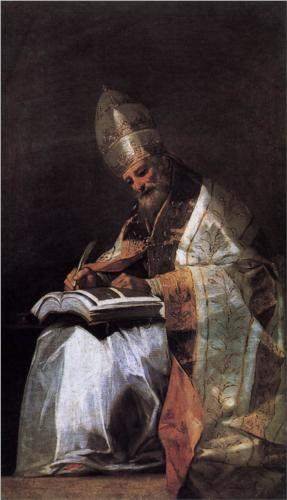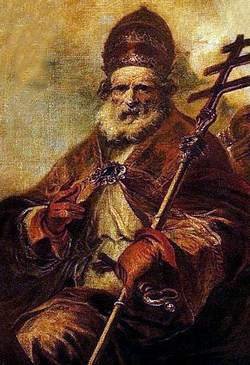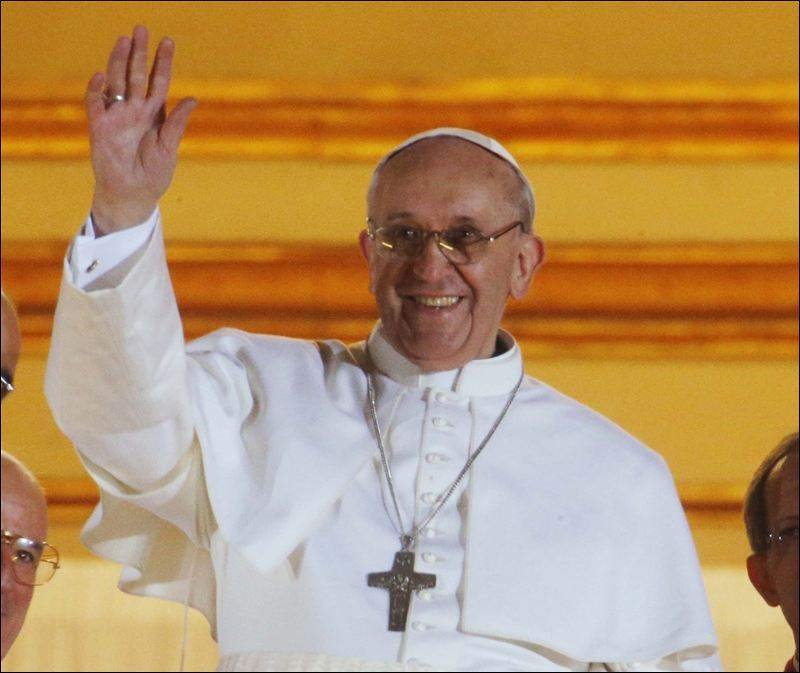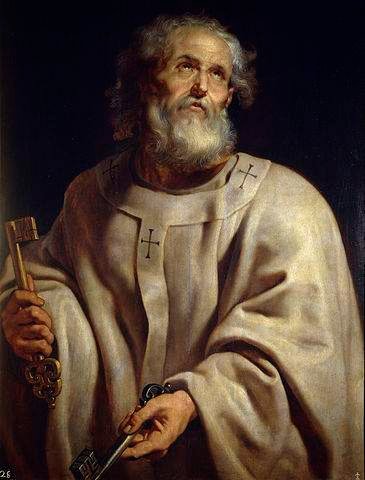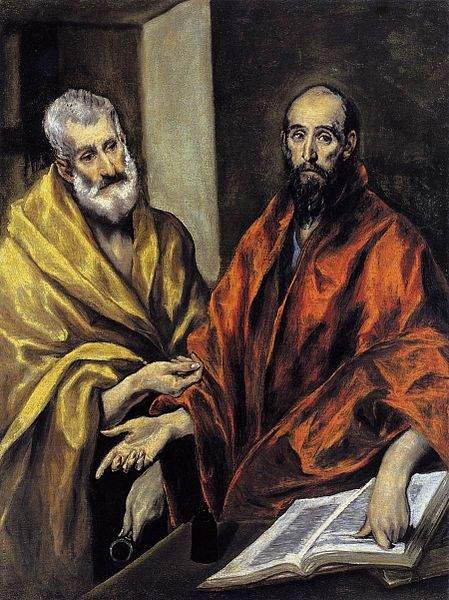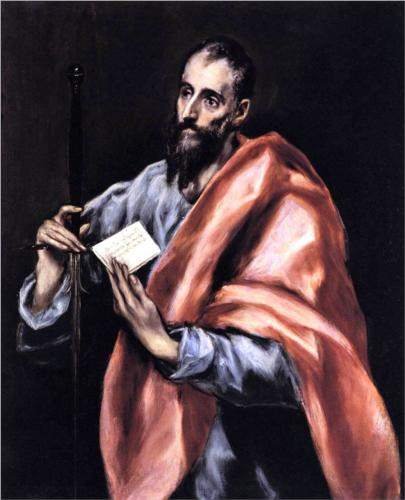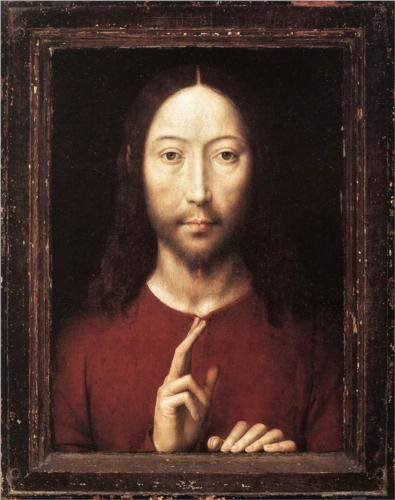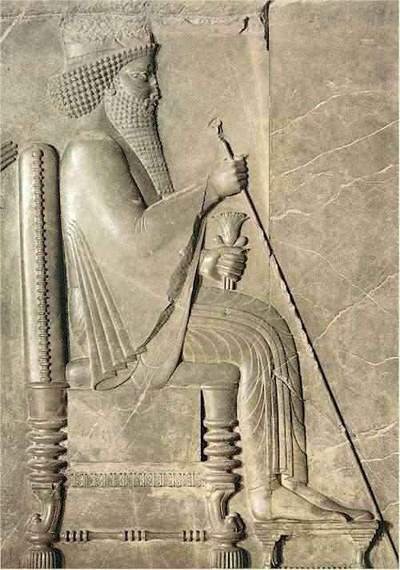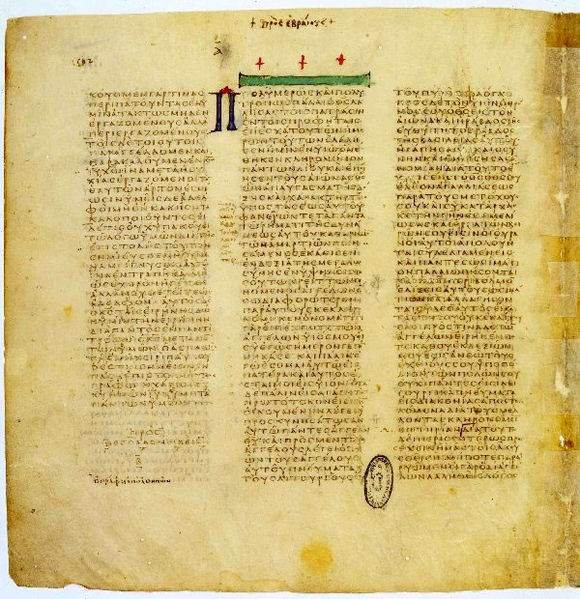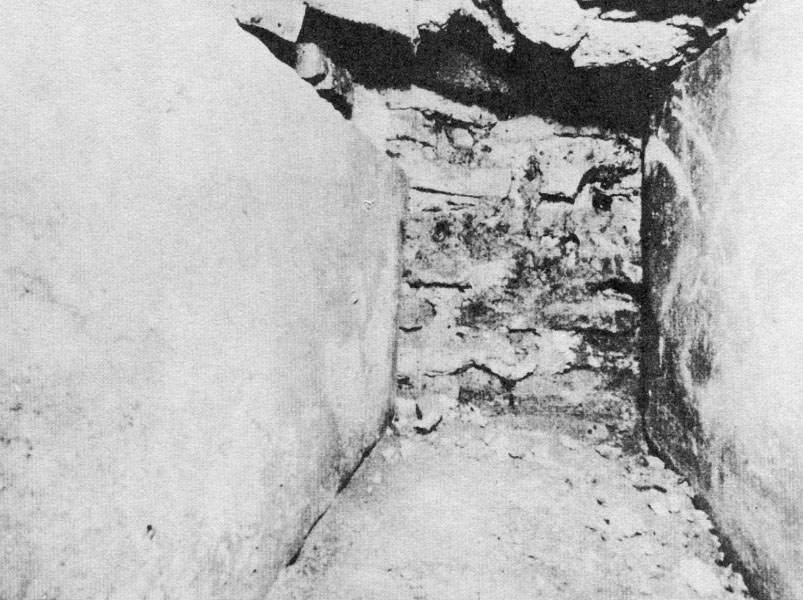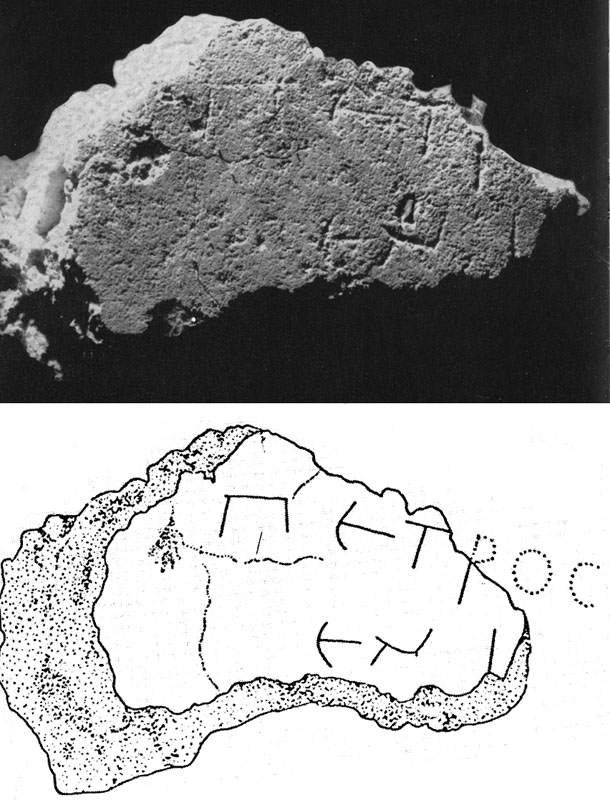Friends, here’s a very detailed post I’ve been working on, answering as comprehensively as I could, from Scripture and history, a question often asked by Protestants: Was Peter really the first pope? I’ve been working hard on this for a couple of weeks, so I hope you enjoy it. If anyone has any further questions or objections, please feel free to throw them at me.
Tag Archives: St. Peter
On the so-called “Jerusalem Tomb of St. Peter”
The past few days, since Pope Francis put some of the relics of St. Peter on display, my blog hits have spiked again. A number of news outlets picked up images from my posts on the Tomb of St. Peter in Rome and linked back here. And this topic continues to fascinate the public as it always has (those posts are by far my most popular) — because, I reckon, the public is just fascinated by bones. Especially long-buried bones. Especially mysterious, even controversial bones. And about that controversy: Coming from the camp of the very same anti-Catholics who seek to argue that St. Peter was never in Rome, there is a claim floating around of a supposed tomb of St. Peter discovered in Jerusalem in 1953 which, if known, would undermine the whole foundation of the Catholic Church and expose the Vatican as a fraud, etc.
There’s one problem, though: the claim itself is a fabrication. The linked article is taken from the pages of a 1971 anti-Catholic tract, self-published by one F. Paul Peterson of Fort Wayne, Indiana, and sold from his home. It is poorly written and rife with factual errors (e.g. the Saracens “never made it to Rome”), unfounded accusations, and unsubstantiated claims. In a tract which purports to provide solid evidence of the burial of the Apostle Peter in Jerusalem, the author actually provides little real evidence other than his own testimony that various people, including a number of well known archaeologists and even Pope Pius XII, agree with him regarding his remarkable discovery and its implications. This is little more than a baseless screed like so much of the anti-Catholic literature out there, akin to Chick tracts and even making similar claims. I normally would not waste my time in responding, but for my concern that this web page is among the top hits on Google for the “tomb of St. Peter.” Anti-Catholics will believe anything — but for anyone out there who is honestly seeking answers, I do not want them to be misled.
For anyone who wants to critically examine this claim of a supposed tomb of Peter in Jerusalem, and the claims of the Catholic Church, here are a few points to consider — just a few of the major problems with this article:
-
The author claims repeatedly that there is “no evidence in either Scripture or history” that Peter was ever in Rome — but clearly either he has not read much history, or he is willfully distorting the truth. I have repeatedly provided evidence, from both Scripture and history. And if one finds Scripture less than explicit, the historical testimony is well documented and compelling.
In fact, there is a unanimous historical tradition that Peter died and was buried in Rome (from Latin trado, trans + do, “to hand over” or “hand down”) — meaning not something vague and “fickle” as Peterson alleges, but attested fact handed down by generation after generation of writers, dating with certainty to the early second century, in all likelihood to within a few years of Peter’s death — and not by “Roman” writers, but by partisans of the Churches of Antioch (e.g. Ignatius), Alexandria (e.g. Clement), Carthage (e.g. Tertullian), and many other scattered places, who would have had no reason to fabricate facts in Rome’s favor. Meanwhile there is no tradition, no testimony, absolutely none, that Peter remained in Jerusalem following the events of the New Testament and died there; no record or attestation or claim that Peter’s tomb ever existed in Jerusalem until this supposed “discovery” came out of nowhere (and in fact never really went anywhere: Peterson’s tract has no doubt had thousands more readers on the Internet than it ever had in his lifetime). While Christians the world over celebrated the tombs and relics of martyrs scattered all over the Mediterranean world and beyond — in some cases no doubt inventing them — no one ever claimed that Peter was in Jerusalem.
Peterson makes repeated statements that are manifestly false, but after reading the piece in depth, I do believe the man is genuine — genuinely ignorant and misled. It being the days before the Internet, I can forgive him for not having ready access to facts; but even today, facts do not get in the way of anti-Catholic delusions.
-
He alleges throughout the piece that there has been a conspiracy to “[put] a smoke screen around the truth” that St. Peter is in fact buried in Jerusalem, reaching to the highest levels of the Catholic hierarchy, to Pope Pius XII; that there are “secrets” in the Vatican that somehow only he is privy to. He envisions himself as the hero who will bring the “truth” to the world:
Having succeeded for so long in keeping ‘this thing quiet,’ … they [Catholics] were off guard when a fellow at that time came along who appeared harmless but persistent. Little did they know that this fellow would publish the news everywhere. Their position in the world is shaky enough without this discovery becoming generally known.
-
He purports to have visited “various renowned archaeologists” to discuss this subject, several of whom he names, and who were indeed renowned archaeologists — William F. Albright (of whom he did not give the full name, only referring to “Dr. Albright of John Hopkins [sic] University”), Nelson Glueck, Józef Milik, Bellarmino Bagatti — each of whom supported and agreed with his unquestionable evidence — and yet none of these renowned archaeologists, in all their well-read and respected works, thought this earth-shattering revelation was worthy of wide publication. Somehow F. Paul Peterson remains the only one who can reveal this news. (He suggests that “Dr. Gluek, being Jewish, is not fully aware … that such a discovery is very embarrassing since it undermines the very foundation of the Roman Catholic Church.”)
-
The latter two archaeologists, Bagatti and Milik, in fact did publish on this matter, Peterson claims. He claims they published a book in Italian, Gli Scavi del Dominus Flevit, which reveals the truth of the tomb of Peter in Jerusalem. But somehow this academic work published by two renowned archaeologists has escaped the notice of not only the archaeological community, but of the entire world, until it was discovered by one F. Paul Peterson of Fort Wayne, Indiana. And this suppressed, forgotten archaeological publication, in which these archaeologists, according to the author, state unequivocally that St. Peter is buried in Jerusalem, not Rome, is so obscure that several thousand books in the Google Books catalog cite it. And yet somehow everyone who reads and cites this work overlooks this astounding revelation.
He also cites numerous unnamed priests and archaeologists who agreed with his evidence: a “highly educated priest,” “a brilliant American priest in Rome,” etc.
-
The claim is that this supposed Jerusalem tomb of Peter was discovered during the excavations of Bagatti and Milik of the ancient Christian necropolis under the Church of Dominus Flevit (“The Lord wept”) on the Mount of Olives (this is the subject of the above mentioned book, per the title). And yet this is now a well-known tourist attraction and site of pilgrimage, and everyone neglects to mention the irrefutable evidence that the Apostle Peter was buried there.
-
The only “solid evidence” which Peterson provides — which “a person who has seen … could never doubt that this truly is the burial place of St. Peter” — is solely that the inscription on an ossuary appeared to read in Aramaic, “Simon bar-Jona.” Yet the names “Simon” (שמעון) and “Jona” (יוֹנָה) or “John” (יוֹחָנָן) are all among the most common Jewish names. Finding a tomb marked “Simon son of Jona” in Jerusalem is no more significant than finding a grave in London marked “John Smith.” That it is an early Christian grave is certainly interesting — because it’s an early Christian grave, not because it is that of Simon Peter.
-
In fact, Fr. Bagatti did publish regarding the tomb in question — not in Gli Scavi del Dominus Flevit, but in an academic journal, Liber Annuus — and it did briefly cause some concern. But rather than shaking the Vatican to its knees, nothing came of the matter. The evidence was considered ambiguous and inconclusive, and not worthy of public attention; certainly it was not “suppressed” or “hidden.” When Milik completed the publication of Gli Scavi del Dominus Flevit, he in fact equivocated on the reading. Nothing in the book makes the bold claim that this was the tomb of the Apostle Peter.
The author of this webpage, not the same anti-Catholic who wrote the article, has posted some scans of pages from Gli Scavi del Dominus Flevit which supposedly prove the claims. But the text says nothing of the sort. In the page purportedly describing the inscription, Milik wrote:
11. locus 79, ossuary 19. In the upper corner on the long side, confidently sketched using charcoal with very fine features; name (length. cm. 9,5; letters 11 – 0,8 – 1,5), fot. 81 and fig. 22,1):
. . . שמעון בר [Simeon bar …]
The reading of the patronym, as luck would have it, is uncertain. The reading proposed in Liber Annuus III, p. 162 (יונה [Jonah]) [this is Bagatti’s article] remains possible, but other possibilities for it can equally be proposed, such as זינה [zinh] correspondent to Ζηνα [Greek Zēna] of n. 21. The two cases of a supposed [Hebrew letter] nun are both a little unusual and the [Hebrew letter] he is rather abnormal although it has an affinity to “Palmyrene”. Alternatively, these last two letters can be considered as a single one, that is, a he with a bifurcated left leg, that would have been inexpertly executed with a piece of charcoal; notice the double feature in the charcoal tracings in fig. 22,7 and 6; fot. 80; LA VII, p. 247, fig. 16. In this case it would have to be read זיה [zih], זוה [zoh], etc.
The writing is cursive. The [Hebrew Letter] shin was made with charcoal by a single stroke; Another unique feature is the curves of the [Hebrew letter] mem and of [Hebrew Letter] 'ain, like a cross formed from two oblique features; [Hebrew letters] beth + resh is a ligature.
On the frequency of this name Simeon, see n. 5.
- This reading itself has been disputed. A fascinating article by Dr. Stephen Pfann of the University of the Holy Land is available online: “Has St. Peter returned to Jerusalem? The final resting place of Simon Peter and the family of Barzillai.” F. Paul Peterson, it seems, is not the only one to have dredged up such a concoction of this charge. It was also featured in the documentary The Lost Tomb of Jesus, in which a hack archaeologist similarly discovered a tomb in Jerusalem marked with the names of Yeshua, Yosef, Miriam (Jesus, Joseph, Mary) — and made the claim we have all heard by now, despite these three names likewise being among the most common Jewish names. Pfann convincingly argues that the ossuary at Dominus Flevit reads “Simeon bar Zilla” — denoting the family of Barzillai, a “Jerusalem family [with] deep roots within Biblical history.”
Herein, lies the greatest proof that Peter never was a Pope, and never was in Rome, for if he had been, it would have certainly been proclaimed in the New Testament. History, likewise, would not have been silent on the subject, as they were not silent in the case of the Apostle Paul. Even the Catholic history would have claimed the above as a fact and not as a fickle tradition.1 To omit Peter as being Pope and in Rome (and the Papacy) would be like omitting the Law of Moses or the Prophets or the Acts of the Apostles from the Bible.
Usually a Catholic, either because he is brainwashed or stubbornly doesn’t want to see anything against what he has been taught, will not allow himself to believe anything against his religion, much less admit it to others. But there is a growing, healthy attitude among many Catholics, to ‘prove all things, hold fast to that which is good’ as the Master admonished us all.
The secrecy surrounding this case is amazing, yet understandable, since Catholics largely base their faith on the assumption that Peter was their first pope and that he was martyred and buried there.
People who lived in Jerusalem all their lives and official guides who are supposed to know every inch of the city, however, knew nothing of this discovery, so well was it withheld from the public.
These figures go along perfectly, as does everything else in the case, with the remains found in the Christian burial ground on the Mount of Olives and in the ossuary on which was ‘clearly and beautifully written,’ Simon Bar Jona in Aramaic.
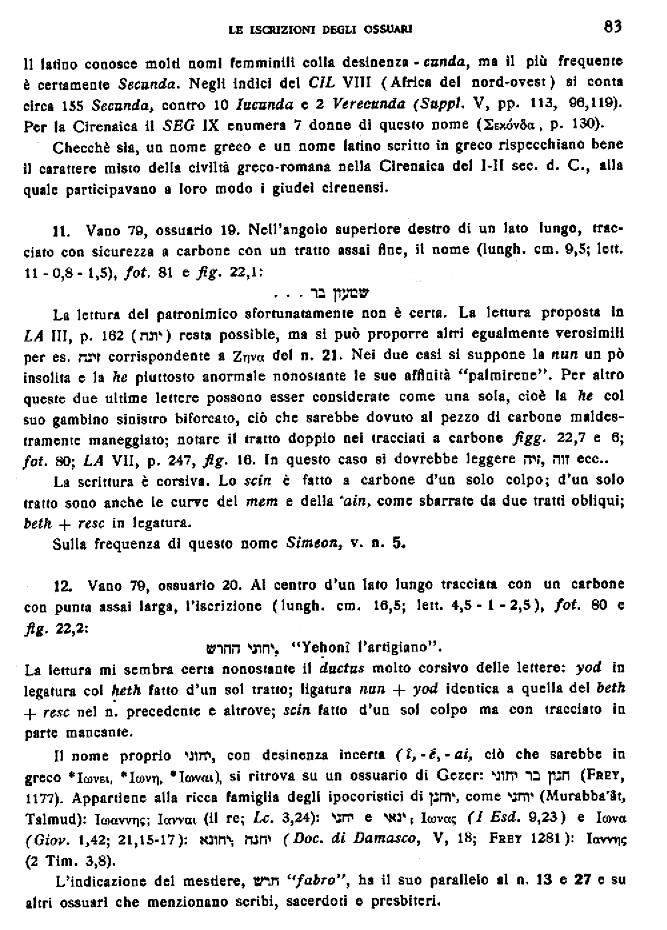
Page 83 of Gli Scavi del Dominus Flavit, purportedly describing this ossuary as that of the Apostle Peter (translation below).
If there remained any doubt that this supposed “Jerusalem tomb of Peter” is not the “indisputable proof” that the Catholic Church is a fraud, or that it is what anti-Catholics have claimed it is, I hope I have dispelled it.
Quickly, before I let you go, I wanted to share a few more priceless claims from Peterson’s article:
-
“Eusebius, one of the most learned men of his time, wrote the Church history up to the year 325 A.D. He said that Peter never was in Rome.1 This Church history was translated by Jerome from the original Greek, but in his translation he added a fantastic story of Peter’s residence in Rome.2 This was a common practice in trying to create credence in their doctrines, using false statements, false letters and falsified history. This is another reason why we cannot rely on tradition, but only on the infallible Word of God.”
1 N.B. Eusebius states numerous times that Peter was in Rome. —JTR2 N.B. The original Greek of Eusebius states that Peter was in Rome. —JTR -
“Mark you, all the priests agree that the Vatican and St. Peter’s were built over a pagan cemetery.1 This was a very appropriate place for them to build since, as even Cardinal Newman admitted, there are many pagan practices in the Roman Catholic Church. You realize surely, that Christians would never bury their dead in a pagan cemetery, and you may be very sure that pagans would never allow a Christian to be buried in their cemetery.”
1 N.B. All cemeteries were pagan cemeteries in first-century Rome, until Christians began to bury in the catacombs in the second or third century. There’s every indication that Peter’s burial in this cemetery, as well as the veneration of the tomb over the cemeteries, was secret and surreptitious. By the time of the cemetery’s destruction and the construction of St. Peter’s Basilica, the cemetery had increasing numbers of Christian burials. —JTR -
“Strange it was, for since beginning to build the church in 1450 (finished in 1626)1 they erected, St. Peter’s Tomb (?) under the large dome and Bernini’s serpentine columns. Since then multiplied millions were thereby deceived into believing that the remains of St. Peter were there, which the hierarchy had all along known was not true, as is proven by the late Pope’s [Pius XII’s] declaration.”
1 N.B. The original St. Peter’s Basilica was begun between 326 and 331. The Church did not suddenly claim in 1450 that Peter was buried on the Vatican under a newly-constructed church. —JTR
I feel rather sorry for Mr. Peterson. Reading his article, I get the sense that he was a good and honest man who sincerely believed (most of) what he was writing. Without a doubt, though, he was stretching the facts quite far in his claims of archaeologists and popes affirming him in his evidence. I sincerely hope this wasn’t him (the only F. Paul Peterson I could find in Indiana).
Biblical Testimony to St. Peter’s Ministry and Death in Rome
(This is a matter I’ve written about before, but not all in one place. And it’s come up in a conversation, so I thought I would put it all together here.)
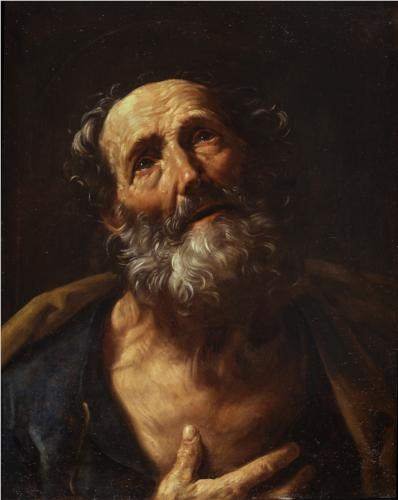
St. Peter Penitent (c. 1600), by Guido Reni. (Wikat least viiPaintings.org)
Anti-Catholics often claim that there is no evidence in Scripture that the Apostle Peter died in Rome or even ever went there. After all, wasn’t Peter the Apostle to the Jews, and Paul the Apostle to the Gentiles? What would Peter have been doing in Rome? Nevermind that early first century Rome had a Jewish population of over 7,000, perhaps many more; or that Peter was the first to preach to Gentiles, just as Paul ministered to Jews everywhere he went. And as a matter of fact, there is strong biblical evidence to place Peter in Rome by the close of the events of the New Testament.
She who is at Babylon
First, and most clearly: Peter tells us himself. In the closing of St. Peter’s first epistle, he writes:
By Silvanus, a faithful brother as I regard him, I have written briefly to you, exhorting and declaring that this is the true grace of God; stand fast in it. She who is at Babylon, who is likewise chosen, sends you greetings; and so does my son Mark. Greet one another with the kiss of love. Peace to all of you that are in Christ (1 Peter 5:12–14)
She who is at Babylon, who is likewise chosen, sends you greetings. Who is Peter talking about? Who is she? And how can someone who is in Babylon be sending greetings through Peter? Does that mean Peter is in Babylon? Let’s take this apart.
First of all, the Greek here — as well as an astute reading of the English — gives us a strong hint who she is. “She who is in Babylon, who is likewise chosen” is ἡ ἐν Βαβυλῶνι συνεκλεκτὴ [hē en Babylōni syneklektē]. What does he mean, likewise chosen? Who else is chosen? For the answer, we return to the opening of the letter:
Peter, an apostle of Jesus Christ, to those chosen sojourning of the Diaspora in Pontus, Galatia, Cappadocia, Asia, and Bithynia, according to the foreknowledge of God the Father, by the sanctification of the Spirit, for obedience and sprinkling with the blood of Jesus Christ: Grace to you and peace, may it be multiplied. (1 Peter 1:1–2, my translation)
I gave my own translation, more literal than any published one (so literal as to sound a little awkward, probably), to preserve the order and emphasis of Peter’s words: Peter’s address is to those chosen. The Greek word here is ἐκλεκτόι [eklektoi] — and this mirrors the word from 5:13, συνεκλεκτόι [syneklektoi = syn + eklektoi], also chosen. This word, ἐκλεκτός [eklektos], from ἐκ + λέγω [ek + legō] — it most literally means to choose out. It is the root of our English words elect and eclectic.

The Crucufixion of St. Peter (1426), by Masaccio (WikiPaintings).
We have here what is called an inclusio, a literary envelope by which the opening and closing of the letter bracket the contents. Peter wants to emphasize the fact of being chosen. The people to whom Peter is writing are those chosen by God, and she who is at Babylon is also chosen or elect. Elsewhere in the New Testament the “elect” refers to all Christians (cf. Luke 18:7, Romans 8:33, 2 Timothy 2:10). And in another place, we find a reference to an unnamed “elect lady”: John the Presbyter writes “to the elect lady and her children” (2 John 1) — and sends greetings from “the children of your elect sister” (2 John 13). Who are these elect ladies, if not the Church, sisters in different places?
But the elect lady at Babylon? If Peter is by her side, then he must be in Babylon, too, must he? Ah-ha! say the anti-Catholics. See! It says Peter was in Babylon, not Rome! But was he really in Babylon, the ancient city in Mesopotamia? Probably not. Alexander the Great conquered Babylonia, and the city of Babylon, in 333 B.C. (and died there). Following Alexander’s death, his vast conquests were divided between his leading generals. Seleucus took Babylonia, and founded the Seleucid Empire, with its capital at the newly-founded city of Seleucia. From that time on, the city of Babylon was in decline, until by the first century A.D. it was mere ruins. The Greek historian Diodorus Siculus (ca. 50 B.C.) attests:
But all these [temple treasures] were later carried off as spoil by the kings of the Persians, while as for the palaces and the other buildings, time has either entirely effaced them or left them in ruins; and in fact of Babylon itself but a small part is inhabited at this time, and most of the area within its walls is given over to agriculture. (The Library of History 2.9.9, ed. by C.H. Oldfather)
Peter would have no reason to be in the literal Babylon. Further, Peter writes as someone under the authority of the emperor (cf. 1 Peter 2:13–17), and as one experiencing the thick of Christian persecution (cf. 1 Peter 4:12, “the fiery trial”), when the first major Christian persecutions began in the city of Rome under Nero — and Mesopotamia was not yet under Roman rule in the first century. But if not the literal Babylon in Mesopotamia, where else might “Babylon” be?
The Beast seated on seven mountains
The Revelation of John refers to Babylon:
And I saw a woman sitting on a scarlet beast which was full of blasphemous names, and it had seven heads and ten horns. The woman was arrayed in purple and scarlet, and bedecked with gold and jewels and pearls, holding in her hand a golden cup full of abominations and the impurities of her fornication; and on her forehead was written a name of mystery: “Babylon the great, mother of harlots and of earth’s abominations.” And I saw the woman, drunk with the blood of the saints and the blood of the martyrs of Jesus. When I saw her I marveled greatly. But the angel said to me, “Why marvel? I will tell you the mystery of the woman, and of the beast with seven heads and ten horns that carries her. … This calls for a mind with wisdom: the seven heads are seven mountains on which the woman is seated; they are also seven kings, five of whom have fallen, one is, the other has not yet come, and when he comes he must remain only a little while (Revelation 17:3–5, 7, 9–10).
In this, John tells us quite clearly where, at least in his symbolism, Babylon is: A city arrayed in purple and scarlet, bedecked with gold and jewels, the mother of earth’s abominations, drunk the blood of the martyrs and saints of Jesus — and seated on seven mountains. One of the traditional marks of the city of Rome is that it was founded on Seven Hills (called in Latin montes, “mountains” — of which, for what it’s worth, the Vatican is not one; the Vatican was outside the walls of ancient Rome). And no other city in the time of the Apostles would have been such a visible image of decadence and extravagance, the capital of a great empire, the seat of fornication and abomination. As the Roman historian Tacitus remarked, it is in Rome “where all things horrible or shameful in the world collect and find a vogue” (referring, ironically, to Christianity). No other city in Peter’s day would have been more “drunk with the blood of martyrs and saints” — the author of the first great persecutions under the emperors Nero (which Tacitus wrote to describe).
But what of the “seven kings”? Can this also be understood to refer to Rome? Quite easily. It even supports an earlier dating of the Revelation than some have supposed, perhaps around the time of Peter’s martyrdom. First-century Rome was ruled by emperors, of whom the most aggressive enemy of Christians was Nero. This post is already too long, but I will allow the good Jimmy Akin to present for you compelling evidence identifying these seven kings and the Beast of Revelation: [Part 1] [Part 2]
It will suffice to say for now that there is very good reason for identifying the “Babylon” of Revelation with Rome — as even anti-Catholics do when they suppose that Catholic Church is the “whore.” If this was the attitude toward Rome in the first century, it would have been one with which Peter was well acquainted. Indeed, no other first-century city could have so aptly resembled the ancient Babylon: the capital of the civilized world, and of a great and mighty empire; the center of decadence and extravagance and idolatry. Peter has just informed us, without a doubt, that he is in Rome.
As does my son Mark
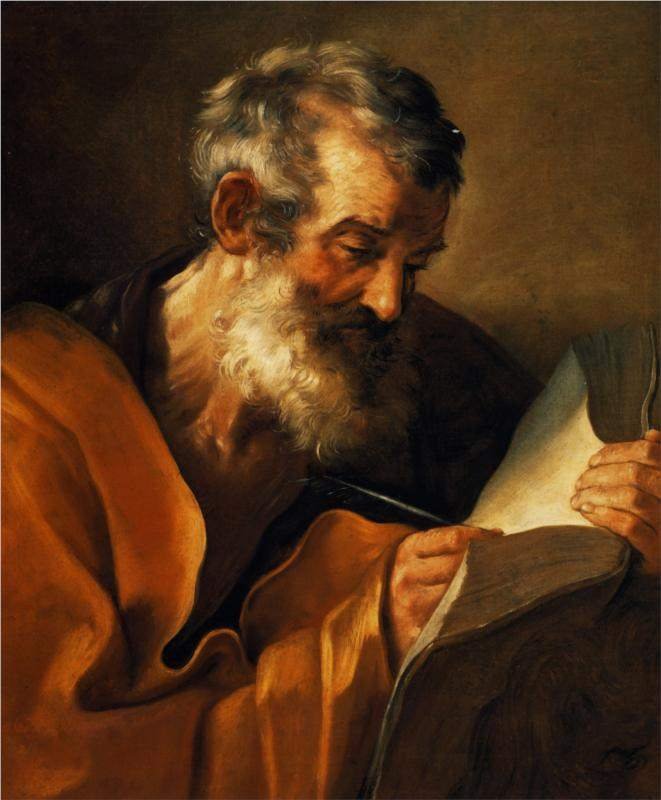
Saint Mark (1621), by Guido Reni WikiPaintings).
And so does my son Mark. In Peter’s closing, he also identifies for us two of his companions who are by his side in “Babylon.” Can this shed any light on Peter’s whereabouts?
Scripture mentions this Mark, the author of the Gospel of Mark, in a number of other places. When Peter was freed from the prison of Herod:
Peter came to himself, and said, “Now I am sure that the Lord has sent his angel and rescued me from the hand of Herod and from all that the Jewish people were expecting.” When he realized this, he went to the house of Mary, the mother of John whose other name was Mark, where many were gathered together and were praying (Acts 12:11–12).
So we see an association between Peter and Mark from the earliest days of the Church, attested to in Scripture.
Later in the same chapter, we find Mark accompanying Paul and Barnabas on Paul’s second missionary journey:
The word of God grew and multiplied. And Barnabas and Saul returned from Jerusalem when they had fulfilled their mission, bringing with them John whose other name was Mark (Acts 12:24–25).
But as they set out for their next journey, Paul and Barnabas had a disagreement over Mark:
And after some days Paul said to Barnabas, “Come, let us return and visit the brethren in every city where we proclaimed the word of the Lord, and see how they are.” And Barnabas wanted to take with them John called Mark. But Paul thought best not to take with them one who had withdrawn from them in Pamphylia, and had not gone with them to the work. And there arose a sharp contention, so that they separated from each other; Barnabas took Mark with him and sailed away to Cyprus, but Paul chose Silas and departed, being commended by the brethren to the grace of the Lord (Acts 15:36–40).
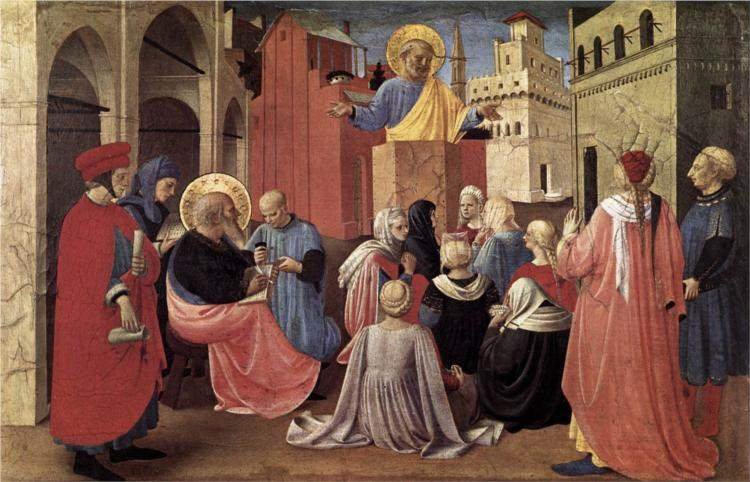
St. Peter Preaching in the Presence of St. Mark (c. 1433) (WikiPaintings).
Now this is important: Barnabas and Mark leave the scene, and Paul takes on a new companion, Silas — also known as Silvanus (cf. Acts 17:15, 18:5; 2 Corinthians 1:19; 1 Thessalonians 1:1; 2 Thessalonians 1:1).
Paul and Mark later reconciled. We next find Mark as a companion of Paul at the time of his writing the epistles to the Colossians and to Philemon:
Aristarchus my fellow prisoner greets you, and Mark the cousin of Barnabas (concerning whom you have received instructions—if he comes to you, receive him), and Jesus who is called Justus. These are the only men of the circumcision among my fellow workers for the kingdom of God, and they have been a comfort to me (Colossians 4:10–11)
Epaphras, my fellow prisoner in Christ Jesus, sends greetings to you, and so do Mark, Aristarchus, Demas, and Luke, my fellow workers. (Philemon 23–24)
We find in these letters that Paul is a prisoner. This is his first captivity — in Rome (cf. Acts 28:16).
Scholars date Paul’s first imprisonment in Rome, and the authorship of these letters, to the spring of A.D. 61 through the spring of A.D. 63 — which also happens to be the range of dates commonly ascribed to the authorship of the first epistle of Peter. So we have, direct from Paul in Scripture, testimony to the fact that Mark was in Rome. And if Mark was in Rome during that time, and was with Peter when he wrote his letter, then it is reasonable to conclude that Peter was also in Rome.
But what of Silvanus? Scripture makes no mention of him following Paul’s third missionary journey (Acts 18:5) — until we find him by Peter’s side in 1 Peter. But as Silvanus was a constant companion of Paul, it would be reasonable to assume that he at least visited Paul in Rome, if not moved the base of his apostolic operations there. The presence of Silvanus by Peter’s side, too, supports the conclusion that Peter was in Rome.
You will stretch our your hands

The Crucifixion of St. Peter (1600), by Caravaggio (Wikipedia).
We have one parting testimony to the end of Peter’s life — in the Gospel of John, widely held to have been one of the last-written books of the New Testament — certainly after the death of Peter:
Jesus said to him, “Feed my sheep. Truly, truly, I say to you, when you were young, you girded yourself and walked where you would; but when you are old, you will stretch out your hands, and another will gird you and carry you where you do not wish to go.” (This he said to show by what death he was to glorify God.) And after this he said to him, “Follow me.” (John 21:18–19)
You will stretch out your hands. In the ancient world — particularly in the Christian tradition — “to stretch out one’s hands” was an almost explicit reference to crucifixion. Indeed, to John the author, this language is meant to be clear to the reader: “This he said to show by what death [Peter] was the glorify God.” Certainly by the time of the writing of John’s Gospel, Peter’s martyrdom had already occurred — so if this were not a true description of Peter’s death (the details of which his readers would have known well), he would not have included it. Further, for Peter’s death to have been by crucifixion, he would have to have been living under Roman rule, since crucifixion was the Roman method of execution: this would not have been the case had he been living in Mesopotamia.
Indeed, the whole tradition of the Church affirms that this was the manner of Peter’s death:
Come now, you who would indulge a better curiosity, if you would apply it to the business of your salvation, run over the Apostolic churches, in which the very thrones of the Apostles are still pre-eminent in their places, in which their own authentic writings are read, uttering the voice and representing the face of each of them severally. . . . Since, moreover, you are close upon Italy, you have Rome, from which there comes even into our own hands the very authority [of Apostles themselves]. How happy is its church, on which Apostles poured forth all their doctrine along with their blood! Where Peter endures a passion like his Lord’s! Where Paul wins his crown in a death like John [the Baptist]’s [and] where the Apostle John was first plunged, unhurt, into boiling oil, and thence remitted to his island-exile! (Tertullian, Prescription against Heretics 36, ca. A.D. 180-200)
Thus publicly announcing himself as the first among God’s chief enemies, [Nero] was led on to the slaughter of the apostles. It is, therefore, recorded that Paul was beheaded in Rome itself, and that Peter likewise was crucified under Nero. This account of Peter and Paul is substantiated by the fact that their names are preserved in the cemeteries of that place even to the present day. (Eusebius of Caesarea, Church History II.25.5, ca. A.D. 290)
So we see that Scripture is plain in testifying to the ministry and death of Peter in Rome. Even those of a sola scriptura mindset should be satisfied. There is no sense in denying that Peter lived and died in Rome — to which the unanimous voice of the Church Fathers and other early writers of the Church testifies, dating to before the close of the first century, and which findings of archaeology confirm. If anyone would deny the truth of the Catholic Church, they must do so on other grounds than the historical.
A Biblical Argument for the Authority of the Papacy
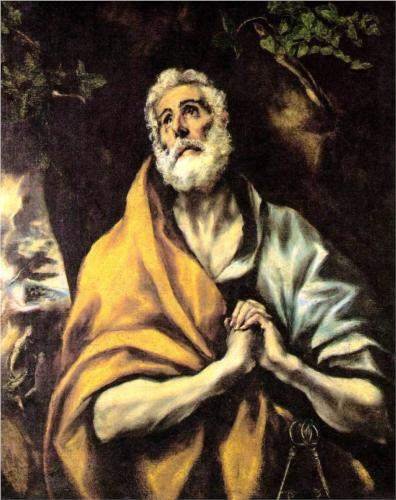
El Greco, The Repentant Peter (c. 1600). (WikiPaintings.org)
Wowzers, you get two posts by me in just two days! I couldn’t help myself. I wrote this piece in response to another post, and come to think of it, I don’t think I’ve ever posted this argument here before.
The title “pope,” to which you objected on the grounds that it can’t be found in Scripture, is only an honorific one; “papa” in Latin is an affectionate term along the lines of “daddy.” The office is another matter. The “pope” is more formally the bishop of Rome, and the office of bishop (ἐπίσκοπος [episkopos]; episcopus in Latin, literally an “overseer”) is quite scriptural (1 Timothy 3, Philippians 1:1, Acts 20:28).
The Catholic Church does not claim, as you suppose, that the successor of Peter is the “earthly head” of the Church: as you say, there is only one Head, and that is Christ. Cf. the Catechism:
“Christ is the Head of this Body”
792. Christ “is the head of the body, the Church.” He is the principle of creation and redemption. Raised to the Father’s glory, “in everything he [is] preeminent,” especially in the Church, through whom he extends his reign over all things.
807. The Church is this Body of which Christ is the head: she lives from him, in him, and for him; he lives with her and in her.
The office of Peter and his successors is merely as the Church’s pastor, its shepherd, the vicar (stand-in, substitute, or representative — not replacement) of Christ:
936. The Lord made St. Peter the visible foundation of his Church. He entrusted the keys of the Church to him. The bishop of the Church of Rome, successor to St. Peter, is “head of the college of bishops, the Vicar of Christ and Pastor of the universal Church on earth” (CIC, can. 331).
Surely you don’t object to pastors, called by God to be the shepherds of their churches? Just as God never left His people Israel without His authoritative voice — through prophets, priests, and kings — Jesus will never leave His people the Church without an authoritative shepherd. And Scripture affirms that He did not.
I think an honest reading of Scripture requires one to acknowledge that Jesus did delegate His authority, first to the Twelve Apostles as a group and then to Peter in particular. The references I could cite are numerous, but I will give you just a few of the most prominent and explicit:
-
Matthew 10:1: And He called to Him His twelve disciples and gave them authority over unclean spirits, to cast them out, and to heal every disease and every affliction.
Matthew 10:5–8: These twelve Jesus sent out, instructing them, “Go nowhere among the Gentiles and enter no town of the Samaritans, but go rather to the lost sheep of the house of Israel. And proclaim as you go, saying, ‘The kingdom of heaven is at hand.’ Heal the sick, raise the dead, cleanse lepers, cast out demons. You received without paying; give without pay.” v. 40: “Whoever receives you receives me, and whoever receives me receives him who sent me.”-
By Jesus’s own words, His gave authority to His disciples, and they received something from Him: the authority to carry out their ministry in His name. He sends them out as His representatives: “Whoever receives you receives me.”
-
-
Matthew 18:18, to the Twelve, in the context of dealing out church discipline: “Truly, I say to you, whatever you bind on earth shall be bound in heaven, and whatever you loose on earth shall be loosed in heaven.”
-
Binding and loosing are rabbinical terms and concepts, which, according to the Jewish Encyclopedia, mean “to forbid and permit” authoritatively with regard to doctrinal and disciplinary pronouncements, such that “they [those with this authority; in the context of the article, the Pharisees] possessed and exercised the power of tying or untying a thing by the spell [i.e. word or formula] of their divine authority, just as they could, by the power vested in them, pronounce and revoke an anathema upon a person.” “This power and authority, vested in the rabbinical body of each age or in the Sanhedrin, received its ratification and final sanction from the celestial court of justice.” I don’t know how you read this, but it sounds very clear to me, first that this authority was Jesus’s to invest in whom He chose (surely the Pharisees would have considered this a gross blasphemy), and second that He invested that authority in His Apostles.
-
-
Matthew 16:17–19, to Peter solely (using singular pronouns and verbs), after Peter confessed Jesus as the Christ: And Jesus answered him, “Blessed are you, Simon Bar-Jonah! For flesh and blood has not revealed this to you, but my Father who is in heaven. And I tell you, you are Peter, and on this rock I will build my church, and the gates of hell shall not prevail against it. I will give you the keys of the kingdom of heaven, and whatever you bind on earth shall be bound in heaven, and whatever you loose on earth shall be loosed in heaven.”
-
Protestants like to reject the “upon this rock” statement with an argument involving the supposed difference between πέτρος and πέτρα in the Greek — but this argument does not hold any weight in Greek, as even most knowledgable Protestant scholars of Greek admit. Jesus’s wordplay between Peter’s name, explicitly stated, “You are Peter (Rock),” and the “rock” upon which Jesus said He would found His Church, mirrors grammatically Peter’s statement: “You are the Christ.”
What is more, that argument does not deal with the other, equally important parts of Jesus’s pronouncement. Jesus gives three separate blessings to Peter and Peter alone which cannot be interpreted in any way but as an explicit investment of authority:
-
You (Peter) are “Rock,” and on this rock I will build My Church, and the gates of hell shall not prevail against it.
-
I will give you (Peter) the keys of the kingdom of heaven [mirroring “the gates of hell”].
-
Whatever you (Peter) bind on earth shall be bound in heaven, and whatever you loose on earth shall be loosed in heaven [linked implicitly to the “keys”].
The fact that each is clearly directed to Peter negates the argument of some that the “rock” of the statement was only Peter’s faith or his confession.
-
-
-
Isaiah 22:20–22, the passage which Jesus was clearly referencing in His speech to Peter, as acknowledged even by Protestant exegetes (cf. ESV Study Bible): [To Shebna, steward of the royal palace:] “In that day I will call my servant Eliakim the son of Hilkiah, and I will clothe him with your robe, and will bind your sash on him, and will commit your authority to his hand. And he shall be a father to the inhabitants of Jerusalem and to the house of Judah. And I will place on his shoulder the key of the house of David. He shall open, and none shall shut; and he shall shut, and none shall open.”
-
This passage describes a stripping of authority from one to whom it had been entrusted and an investment of that authority in someone new. In the context of the passage in Matthew and its application to Peter, the authority of binding and loosing with divine approval (“opening” and “shutting” the gates of the kingdom of heaven, with the key), which had been entrusted to the Jewish rabbinical body and the Sanhedrin, was now being removed and entrusted to Peter and the Apostles in Christ’s new order — from the rabbinical, teaching authority of the Jewish people to the episcopal, teaching authority of the Church, the Magisterium. Peter is installed as steward over the house of Judah, to exercise order over the household [the Church] in the absence of the king [Christ]. Christ certainly foreshadowed this stewardship in His parables about wise and foolish stewards or servants and their care for the affairs of the house while their master is away (Luke 12:35–48, Matthew 24:45–51). And what is more: he shall be called a father to the house of Judah: just as the bishop of Rome is called a Father to the Church: he is called the pope (papa), or the Holy Father. Given this understanding, the kissing of a ring — a very ancient sign of respect and acknowledgement of authority, not of worship — begins to make a bit more sense.
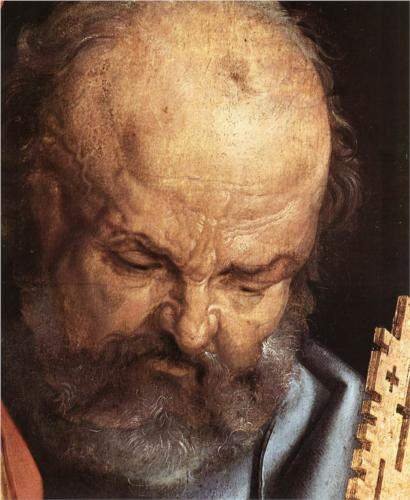
St. Peter, by Albrecht Dürer (1471–1528). (WikiPaintings.org)
-
-
John 20:21–23, Jesus appearing to the Apostles after His Resurrection: Jesus said to them again, “Peace be with you. As the Father has sent me, even so I am sending you.” And when he had said this, he breathed on them and said to them, “Receive the Holy Spirit. If you forgive the sins of any, they are forgiven them; if you withhold forgiveness from any, it is withheld.”
-
Just as the Father sent [Jesus], Jesus sends the Apostles in continuation of His ministry and authority, “to make disciples of all nations” (Matthew 28:18–20) and continue doing what He was doing. Just as Jesus has the authority to forgive sins (Mark 2:10–12) — an authority with a clear association to physical healing (cf. James 5:13–16) — He imparts that authority to the Apostles — with an implicit connection to that of “binding and loosing,” but rightly exceeding any authority before claimed by any other rabbi.
-
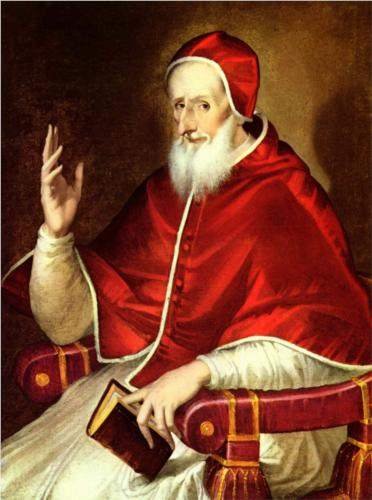
El Greco, Portrait of Pope Pius V (c. 1605) (WikiPaintings.org)
Evidently, we Catholics interpret Scripture more literally and realistically than you, and accept it more readily for what it actually says in its plainest sense. I don’t think that leaves you much ground to stand on from which to accuse the Catholic Church of “unbiblical practices.”
Some Answers to Common Protestant Objections to Peter’s Ministry as Bishop of Rome
Hi. I am sorry that I’ve been such an absentee tenant lately, but I’ve been swamped in the mud bog of my thesis. Today has been a new day of positive meetings with my professors and friends, so I hope and pray I can put some step back into it.
I am thrilled by the election of Pope Francis to the See of Peter, and already love him dearly. Even many Protestants have been caught up in the worldwide excitement that he has elicited (SatelliteSaint has some thoughtful words on “that feeling”) — for both better and worse. While many, with the rest of Christendom, have been filled with great joy and fascination, others, as if to actively reject and deny that joy, have seized the opportunity to lash out in scorn and prejudice and carve even deeper the sad divisions in the Body of Christ.
Consequently, I have been having some random apologetic discussions here and there, and today I wrote a brief response (inspired by this post) to some common objections I’ve often heard from Protestants with regard to the Apostle Peter’s ministry in Rome as its first bishop — the foundations of the papacy. Since I’ve already written it, and thought it a direct and concise argument, I thought I’d share it with you.
Scripture clearly states that Christ called Peter to be the Apostle to the Jews, and Paul to be the Apostle to the Gentiles (Galatians 2:7–9, 2 Timothy 1:11, Romans 15:16–18). Therefore Peter would never have become bishop of Rome, a city of Gentiles.
Peter’s primary calling was to the Jews, just as Paul’s primary calling was to the Gentiles. But Peter’s ministry was not limited or restricted to the Jews, any more than Paul’s was restricted to the Gentiles: In fact Paul preached to Jews everywhere he went; his first stop was always the local synagogue (Acts 13, 14, 17, 18, etc.). Peter likewise ministered to the Gentiles: in fact it was to Peter, not Paul, that Christ gave the definitive vision that salvation was for the Gentiles as well as the Jews, and Peter is responsible for the first prominent Gentile converts in the family of Cornelius (Acts 10). To quote Peter himself at the Council of Jerusalem:
Brothers, you know that in the early days God made a choice among you, that by my mouth the Gentiles should hear the word of the gospel and believe. (Acts 15:7)
This is not even to mention that there was a large and prominent population of Jews in Rome which Peter pastored: as many as the first ten popes are believed to have been Jewish Christians.
Paul, in his letter to the Romans, writes of “imparting a spiritual gift” to the Roman Christians, that they may “be established” (Romans 1:11); so the Church at Rome was not established at the time of Paul’s writing and could not have been founded by Peter.
Nobody claims that Peter or Paul are responsible for the first Christian converts in Rome; Paul’s letter very well indicates that there was already a Christian community there. Also, nobody claims that Peter single-handedly founded the Roman Church: the Church teaches that the early ministries of both Peter and Paul, through Christ, laid the foundations of the Church, the pillars upon which the Church was built. By analogy, George Washington didn’t “found” the U.S., but he was nonetheless its first president and is called a “Founding Father,” even though many men had worked for the cause of revolution and independence before him. Likewise Peter and Paul are the “Founding Fathers” of the Roman Church.
Paul never mentions in any of his letters that Peter was in Rome, especially not in Romans 16 when he offers greetings to the people of the Church there, or in the accounts of Paul’s arrest, trial, and imprisonment in Rome (Acts 28). Therefore Peter was not there in Rome.
He wasn’t there yet. Paul likewise hadn’t set up permanent residence in Rome yet, but we know that Peter and Paul ministered there at the same time and both died there. Tradition holds that Peter ministered in Antioch (where he was also the first bishop) before coming to Rome, and together with Paul, in Corinth. All of this would have taken place after the Epistle to the Romans, the Acts of the Apostles, and many other New Testament documents, were written.
At the end of Paul’s life, in his final letter, Paul states that “only Luke is with me” in his final imprisonment in Rome (2 Timothy 4:11) — therefore Peter was not there.
Paul’s statement that “only Luke is with me” is not a statement that there were no other Christians in Rome — in fact there was a thriving Christian community by that time, or else there wouldn’t have been a letter to them. Certainly he meant “only Luke is with me” by his side, in prison, or in his house arrest.
Paul’s statement also that at his trial “all deserted me” (2 Timothy 4:16) likewise does not entail that “all” of the Church, or Peter specifically, deserted him, or were not in Rome at all. Certainly there was a substantial Church at Rome, as history records the first bloody persecutions of a great number of Christians under Nero around that time, during which both Paul and Peter met their martyrdom. In the context of this statement, Paul is clearly not referring to his desertion by the leaders of the Church, but by men of high rank or influence with whom he’d become acquainted whose testimony might have made a difference in his trial.
In fact, Peter himself tells us that he was in Rome:
She who is at Babylon, who is likewise chosen, sends you greetings, and so does Mark, my son. (1 Peter 5:13)
Certainly Peter was not literally writing from the ancient “Babylon,” which had lain in ruins for centuries, but from the modern Babylon, the great whore that John describes in the Revelation — Rome itself.
You don’t have to take my word for it. Here is the interpretation of the editors of the well-respected Protestant ESV Study Bible:
1 Pet. 5:13 She who is at Babylon, who is chosen almost certainly refers to the church in Rome, not a literal woman (cf. “elect lady,” 2 John 1, 13). Although the Babylon of the OT was in ruins, the reference resonates with the OT, where “Babylon” represents a center of earthly power opposed to God (cf. Isaiah 13:14; Jeremiah 50:51; see also Revelation 17:18), and in Peter’s day that city would be Rome. The language of “Babylon” and “chosen” forms an inclusio (a literary envelope) with the first verse of the book: the OT background to “Babylon” reminds believers that though they are exiles, they are “elect exiles” (1 Pet. 1:1) who will receive the promised inheritance. Mark is the same John Mark who traveled with Paul and Barnabas on their first missionary journey (cf. Acts 12:25; 13:5, 13; 15:36:39). Though he left Paul and Barnabas, he was later restored to his former usefulness (Col. 4:10; 2 Tim. 4:11; Philem. 24). Peter would have known Mark from the earliest days, because the church met in his mother’s home (Acts 12:12). In addition, this verse shows a close relationship between Peter and Mark (my son) and is one indication of the validity of the early church tradition that Mark wrote his Gospel at Peter’s direction.
These are only a few of the common Protestant objections to the claim of Peter’s ministry in Rome; but the facts speak for themselves, through incontrovertible biblical, historical and patristic, and archaeological evidence. The See of Peter can only be denied by denying these truths on their face.
“Rigorously skeptical”: Historical thoughts on the Christian faith
[This is a post that ballooned into about three posts when I sat down to write it. So I split it up, rather than giving you far more than anyone wants to read.]
Once again, my plans for what I was going to write about today have been disrupted. I had a heated discussion with a dear friend today that has set me to thinking. My friend is a self-proclaimed atheist, but a former Christian who has been deeply wounded. He is a thinker, a philosopher, and his mind works in ways that mine cannot. But I wanted to do my best to address his questions in a more thoughtful way, not in the heat of a moment.
To preface, I will say that though I’ve had some academic training, I am not an academic. I have not read deeply of the academic historiography of the early Church. I am a man of faith, and my faith informs everything I do. But my friend challenged that the historical claims of the Christian Church do not stand up to a “rigorously skeptical” examination; that they cannot be accepted without presuming that the claims of the Church are true, resulting in a circular argument. I disagree.
First, what is reasonable to expect in holding historical claims to a “rigorously skeptical” standard? Aren’t there many things in history that we accept as fact based on little and imperfect evidence? My friend has a background in ancient history, and though I’ve dabbled in that some, that has never been my bag; so I admit I am arguing from something I don’t know much about. But don’t we generally accept the narrative of the Persian Wars of Greece given by Herodotus and Xenophon, though neither was a contemporary, or Livy’s account of the early Roman republic, though he only saw the end of it? In the absence of any other testimony, it seems, historians treat theirs with reasonable skepticism, but nonetheless accept them as the best sources we have. Early Christianity and the historical testimonies to it should be held to the same standard.
So let’s take a look at early Christianity. My friend argues, as is widely accepted by secular academics, that there was no Christian orthodoxy in the beginning, and that what we today accept as “orthodoxy” is only the victor of a battle for supremacy among many competing Christian sects. All of my arguments, he challenges, rest on the assumption that the “orthodox” account of early Christian history today is true. He challenges that there are contradictions and inconsistencies in the New Testament that evince this early factiousness.
I accept, with every reasonable textual scholar, that there are certain problems and inconsistencies in the text of the New Testament; but these, I argue, are minor, involving only details and chronologies, and do not affect the substance of any Christian doctrine they teach. These inconsistencies show only that the New Testament documents were written by different people at different times in different places, and that the authors weren’t all in constant communication with each other, to compare their notes and get their facts straight. To me, these inconsistencies are an argument in favor of the historical reliability of the New Testament rather than against it: we have several different people telling a story that is substantially the same.
Doctrinally, the documents of the New Testament demonstrate an even more telling consistency. Despite differences in emphases, each of the half-dozen or so writers of the New Testament (Matthew, Mark, Luke, John, Peter, Paul, James, Jude — even more if one argues that John the Evangelist and John the Presbyter and John the Revelator were different people) expresses the same basic doctrines about Christ: that he was the Jewish Messiah, the fulfillment of Old Testament prophecies; that he was the divine Son of God, to be identified with God Himself; that he died, was resurrected, and would come again in glory.
[It feels so unsatisfying to cut it off there. But that just gives you something to look forward to tomorrow.]
Saints Peter and Paul: Apostles to the Protestants?
Today is the Feast of Saints Peter and Paul, two saints who almost need no introduction: they are the most prominent men, besides Jesus, in the New Testament — Peter, the foremost of the Apostles, on whom Christ said he would found His Church; and Paul, the Apostle to the Gentiles, radically converted on the road to Damascus, and from then on a tireless preacher and writer for Christ. Together, the two became pillars of the Church of Rome, and watered it with the blood of their martyrdoms. Peter especially, hailed by the Roman Catholic Church as the first bishop of Rome, has come to be, for Catholics, a symbol of the authority of the Church. Paul, on the other hand, became a central figure of the Protestant Reformation: his writings on grace and faith and works, against the Judaizers, formed the basis of Martin Luther‘s theological interpretations. A number of Catholics I’ve talked to have seemed to distance themselves from Paul because of this, strangely. To me, though, Peter and Paul are the essential apostles who can bridge both the Catholic and Protestant traditions, and even offer hope of the reunion of all Christians.
There was a reflection in Magnificat last night, for the Vigil of Peter and Paul, that gave me a start and inspired this entry for today.
By celebrating the memory of these two great saints together, we remember how valiantly — and humanly — they struggled to bring together into one Church under one Gospel those who were divided by the differing heritage and belief of Jew and Gentile.
Up until the last two words, my mind was somewhere else — on our division today. I was nearly expecting to read of the “differing heritage and belief of Catholic and Protestant.”
St. Paul is my patron saint. As I journeyed to the Church, I pondered who I should choose; but when I prayed about it, I realized that there could be no other choice but Paul. For Paul was choosing me. There is no doubt in my mind at all that Paul has been looking out for me all these years since my youth. Most Protestants turn to Paul for his theology and intellect, but through all my troubles growing up, I turned to Paul for encouragement and comfort.
Do not be anxious about anything, but in everything by prayer and supplication with thanksgiving let your requests be made known to God. And the peace of God, which surpasses all understanding, will guard your hearts and your minds in Christ Jesus (Philippians 4:6-7).
When I reached Rome the first time and stood at Paul’s tomb, it was his words of encouragement that came flooding back to me, that brought me to knees and urged me to come face to face with God. And as I approached Rome again, toward the Church, I believe that Paul was praying for me, and welcoming me home.
I appeal to you, brothers, by the name of our Lord Jesus Christ, that all of you agree, and that there be no divisions among you, but that you be united in the same mind and the same judgment. For it has been reported to me by Chloe’s people that there is quarreling among you, my brothers. What I mean is that each one of you says, “I follow Paul,” or “I follow Apollos,” or “I follow Cephas,” or “I follow Christ.” Is Christ divided? Was Paul crucified for you? Or were you baptized in the name of Paul? (1 Corinthians 1:10-13 ESV)
And I truly believe that just as the Protestant Reformers’ interpretations of Paul remain at the heart of our division, a deeper reflection on both Peter and Paul — what they believed, what they wrote, what they stood for, and what they died for — can help heal our breach. “I appeal to you, brothers,” Paul wrote, “by the name of our Lord Jesus Christ, that all of you agree, and that there be no divisions among you, but that you be united in the same mind and the same judgment.” “Is Christ divided?,” he asks us (1 Corinthians 1). Tragically, we ourselves have divided the Body of Christ on earth, and have perpetuated that division for 500 years in the case of the Protestants; for 1,000 in the case of the Orthodox. And we ourselves are to blame for every day that we allow it to continue. Christ wants to return for a whole and spotless Bride. I believe we owe it our Lord, to His Church, and to His Apostles to urgently seek understanding and reconciliation as we near the end of this age.
On this Rock: An Analysis of Matthew 16:18 in the Greek
One of the Roman Catholic Church’s chief scriptural supports for the authority of St. Peter as the leading Apostle, who would become the bishop of Rome — whom we would eventually refer to as the first pope — is the verses of Matthew 16:17-19:
And Jesus answered him, ‘Blessed are you, Simon Bar-Jonah! For flesh and blood has not revealed this to you, but my Father who is in heaven. And I tell you, you are Peter, and on this rock I will build my church, and the gates of hell shall not prevail against it. I will give you the keys of the kingdom of heaven, and whatever you bind on earth shall be bound in heaven, and whatever you loose on earth shall be loosed in heaven.’
This is also a favorite passage of anti-Catholics to pick apart. But with even a basic understanding of the ancient languages, the wordplay that Jesus and the Evangelist were implementing here becomes clear: These verses cannot be interpreted any other way but as an explicit declaration of Peter’s authority. And they never were, until the time of Luther.
Let’s look at the Greek, especially of the critical verse 18 (Greek text from NA27; see also, in English, BibleGateway, Bible.CC, New Advent):
κἀγὼ δέ σοι λέγω ὅτι σὺ εἶ Πέτρος, καὶ ἐπὶ ταύτῃ τῇ πέτρᾳ οἰκοδομήσω μου τὴν ἐκκλησίαν, καὶ πύλαι ἅδου οὐ κατισχύσουσιν αὐτῆς.
Now, I don’t expect my readers to have a lot of Greek. If you do, I am delighted — but I’m here to make this as simple as possible. Here it is transliterated into Roman characters:
kagō de soi legō hoti su ei Petros, kai epi tautē tē petra oikodomēsō mou tēn ekklēsian, kai pulai hadou ou katischusousin autēs.
And one more time, all together: this time cribbed so you can understand it.
κἀγὼ [I, emphatically, in response to Peter’s delaration] δέ [and, also, postpositive: together with first word, and I or I also] σοι [2nd person singular dative pronoun, to you] λέγω [(I) say] ὅτι [that] σὺ [2nd person singular nominative pronoun, you, emphatically] εἶ [2nd person singular present active, are] Πέτρος [Peter], καὶ [and] ἐπὶ [preposition on, upon] ταύτῃ [this] τῇ πέτρᾳ [rock] οἰκοδομήσω [first person singular future active I will build, as in building a house] μου [my (lit. of me)] τὴν ἐκκλησίαν [church (lit. a calling out, a meeting, an assembly — but concretely and universally in Christian lit. refers to the Church)], καὶ [and] πύλαι [(the) gates] ἅδου [of hades] οὐ [negative particle, not] κατισχύσουσιν [3rd person plural future active, will overpower] αὐτῆς [it].
Now, the first thing to note about this is that Jesus addresses Peter in the second person singular: that is, he says you and not y’all. The distinction between the second-person singular and plural personal pronouns has died out in modern English; technically, the singular personal pronouns (thou, thy, thee) have died out and been replaced by the plural (ye, your, you). This is why the Southern U.S. y’all will save the English language. But back to the point: Jesus addresses Peter in the singular you — the King James’ Thou art Peter actually preserves the important distinction. So there can be no question that Jesus is speaking to Peter and to Peter alone here; not to all the Apostles; not to all Christians.
Second, and more important: the wordplay. The name “Peter” — Petros in Greek, Petrus in Latin — translates as “Rock.” Jesus is giving Simon a new name, Peter or Rock, in reference to his firmness or steadfastness.
And on this Rock I will build my Church. “You are Rock, and on this Rock I will build my Church.” That’s the proper way to understand the statement, had it been spoken in English.
Now, the common anti-Catholic refutation of this is thus (first put forward by Luther himself): the Evangelist uses different words in the Greek for Peter and Rock. You are Peter (Πέτρος, Petros) and upon this Rock (πέτρα, petra) I will build my Church. Not only are the two words different, but they are different genders — Petros is masculine and petra is feminine — and they have supposedly, according to the Protestant argument, different meanings in Greek. A petros is a small rock or a piece of rock; a petra is the bedrock or a massive rock formation. Therefore clearly, Jesus wasn’t referring to the same rock in both cases, so the argument goes.
There are several reasons why this argument doesn’t work. First of all, the context. Jesus had asked the disciples who they said he was: John the Baptist, Elijah, Jeremiah, some other prophet? And in one of the most dramatic moments of the Gospel, Peter confesses that Jesus is the Christ. And Jesus in turn confesses Peter: “Blessed are you, Simon Bar-Jonah! For flesh and blood has not revealed this to you, but my Father who is in heaven. And I say to you . . .” The episode would not make any sense if Jesus had said, “I rename you Peter, a steadfast Rock; and on this (other) rock I will build my Church.”
Not only does that not make sense — but Jesus doesn’t say “other” — he says ταύτῃ, this rock. And there doesn’t seem to be any other rock, any petra present. The common Protestant argument is that petra here refers to Peter’s confession or Peter’s faith. But if that were the case, why the wordplay on Peter’s name? Even more so, why the wordplay without any clarification of the ambiguous metaphor? It seems unlike Matthew to let such an ambiguous statement go without explanation, who in other places is careful to provide explanations for the fulfillment of prophecies (Matthew 3), difficult parables (Matthew 13), and foreign words (Matthew 27:46). The reason he doesn’t here is because to Matthew, and to his earliest readers, it wasn’t ambiguous.
In fact, the literary structure of Jesus’s proclamation mirrors Peter’s exactly: “You are the Christ”; “You are Peter.” And Jesus’s other pronouncements here are perhaps even more important, more indicative of Peter’s singular authority, than His pronouncement of Peter as “Rock”. Jesus gives three separate blessings directed to Peter and Peter alone that leave no doubt of His intention to invest Peter specifically with authority:
-
You (Peter) are “Rock,” and on this rock I will build My Church, and the gates of hell shall not prevail against it.
-
I will give you (Peter) the keys of the kingdom of heaven [mirroring “the gates of hell”].
-
Whatever you (Peter) bind on earth shall be bound in heaven, and whatever you loose on earth shall be loosed in heaven [linked implicitly to the “keys”].
Further, there is no evidence, beyond the assertion itself, that the meanings of petros and petra are as distinct as Protestants argue. No scholarly lexicon I have consulted, in particular neither the LSJ for Classical Greek nor the BDAG for Koine, supports the definiton of petros as merely a small rock or piece of rock. The words seem, rather, to be nearly synonymous. If there is a distinction between them at all, it is between petra, a great mass of rock, and petros, stone as a monumental building material — for building, say, a Church.
But most important: there are perfectly good reasons why Matthew used two different words here, Petros and petra: this was the only way to compose the statement so that it would make sense in Greek.
- Peter’s name in Greek is Petros, not Petra. Why didn’t they call him Petra in Greek? Because Petra is a feminine noun, and Peter is a male. By the time the Gospels were written, Petros had been his Greek name for decades.
- Even supposing the Protestant argument about the different meanings of the words petros and petra were true (all evidence is that this is an anti-Catholic invention) — Jesus wouldn’t have said “on this petros I will build my Church,” to make the statement in Greek seem less ambiguous (to us), because that wasn’t what He meant. He meant “I will build my Church on this bedrock,” this unmovable foundation, not this piece of rock.
- Greek is an inflected language, meaning that the endings of words change depending on the grammatical function in which they are used. For example, πέτρος (petros), πέτρον (petron), and πετρῷ (petro[i]) are all the very same word. So variations in the endings of words with the same stem seem quite natural to the Greek mind, and the difference between petros and petra would have seemed much less significant than it does to an English-speaker. In fact, this type of wordplay between similar-sounding words, called paronomasia, was common in ancient Greek.
- Jesus wasn’t speaking Greek at all. Scholars are pretty certain that in His day-to-day life and teachings, Jesus spoke Aramaic. The Gospels quote Jesus in Aramaic for special dramatic emphasis: “Talitha cumi” (Mark 5:41), “Abba, Father” (Mark 14:36), “Eloi, Eloi, lema sabachthani?” (Mark 15.34).
- So if Jesus was speaking Aramaic, the words for Peter and Rock — Petros and petra — would have been the same word: Kepha (כיפא).
“You are Kepha and on this Kepha I will build my Church,” is what Jesus would have said (pretending that the rest of the sentence is in Aramaic, which I don’t know, and you probably don’t either). - The Aramaic Kepha (כיפא) was rendered into Greek as Kephas (Κηφᾶς). Why didn’t Matthew just use that in both cases? Because it would have been as awkward as my sentence above, saying most of the sentence in Greek and a couple of words in Aramaic, and then having to explain it. Matthew’s readers apparently didn’t know Aramaic — or at least, if the book was originally written in Hebrew or Aramaic as some of the Church Fathers suggest, whoever translated it into Greek didn’t expect his readers would know Aramaic, and provided a crib for the Aramaic phrases.
To further confirm the Catholic interpretation — it’s not a Catholic interpretation; at least not an invention or reinterpretation of the modern Catholic Church as anti-Catholics charge. This is the way this Scripture has been interpreted since the very earliest biblical commentators:
“. . . I think it my duty to consult the chair of Peter, and to turn to a Church whose faith has been praised by Paul . . . The fruitful soil of Rome, when it receives the pure seed of the Lord, bears fruit an hundredfold . . . My words are spoken to the successor of the fisherman, to the disciple of the Cross. As I follow no leader save Christ, so I communicate with none but your blessedness, that is with the chair of Peter. For this, I know, is the Rock on which the Church is built! This is the house where alone the Paschal Lamb can be rightly eaten. This is the Ark of Noah, and he who is not found in it shall perish when the flood prevails.”
—St. Jerome, To Pope Damasus, Epistle 15:1-2 (A.D. 375)
“Number the bishops from the See of Peter itself. And in that order of Fathers see who has succeeded whom. That is the rock against which the gates of hell do not prevail.”
—St. Augustine, Psalm against the Party of Donatus, 18 (A.D. 393)
“Wherefore the most holy and blessed Leo, archbishop of the great and elder Rome, through us, and through this present most holy synod together with the thrice blessed and all-glorious Peter the Apostle, who is the rock and foundation of the Catholic Church, and the foundation of the orthodox faith, hath stripped him of the episcopate, and hath alienated from him all hieratic worthiness. Therefore let this most holy and great synod sentence the before mentioned Dioscorus to the canonical penalties.”
—Council of Chalcedon, Session III (A.D. 451)
To me, this makes a rock-solid (that’s petra-solid) case: In this verse, there is no doubt that Jesus is declaring Peter to be the Rock on which He would build his Church. Seeing these words in stone did more to move me to this truth, and toward the Catholic Church, than almost anything else: my banner above is a photograph I took of this same declaration, in Latin, around the dome of St. Peter’s Basilica, over the high altar and St. Peter’s tomb.
Early Testimonies to St. Peter’s Ministry in Rome
So I’m realizing why the “tomb of st. peter” is such a popular search term. It seems the issue of St. Peter’s presence and ministry in Rome is one of the major points of contention between Catholics and many Protestants (especially those of an anti-Catholic bent). This is somewhat surprising to me. Even as a Protestant, there was never any question in my mind that Peter ministered and died in Rome — perhaps because I’m also an historian. The historical evidence for Peter being in Rome is not just solid; it’s unanimous. Every historical record that speaks to Peter’s later life and death attests that he died in Rome a martyr under the emperor Nero, ca. A.D. 67. No record places the end of his life anywhere else.
The fact that so many people are searching on Peter in Rome tells me that people are hearing conflicting statements and wondering, searching for the truth. The fact that so many Protestants deny it so vehemently, and refute it so absurdly, tells me that they, however basically, realize the power in our claim. They recognize and in effect acknowledge what we have maintained for many centuries: that having the chief of Apostles as our foundation gives the Roman Catholic Church legitimacy and primacy.
Why else would it be so important to refute that St. Peter was here? He was but a man who died nearly 2,000 years ago. If, as Protestants charge, the Catholic Church left its apostolic foundations long ago and drifted over the centuries into corruption, why should it be so significant what those foundations were? Why deny a well-attested historical fact unless it carries some continuing authority? Do they not realize that in attacking the Roman Church’s foundations, they are undermining their own — since we are their Mother Church, too?
The primary reason for this opposition, I suspect, is that in a fundamentalist view, all religious truth must come from Scripture, sola scriptura — and it is not self-evident from Scripture that St. Peter was ever in Rome. This is also the reason why few Protestants seem to dispute that St. Paul was in Rome: because he tells us he was, repeatedly, in his scriptural epistles. Most more thoughtful Protestants realize that there is a difference between religious truth and historical truth, however intertwined the two may sometimes be; and historical sources are valid authorities for historical truth. These tend to be, incidentally, the Protestants least inclined toward anti-Catholicism.
First Epistle of St. Peter
But the Bible can be an historical source, too. And there is actually a significant testimony in the Bible to Peter’s presence in Rome. In the valediction of Peter’s first epistle, he wrote (1 Peter 5:13 ESV):
She who is at Babylon, who is likewise chosen, sends you greetings, and so does Mark, my son.
Here the Greek grammar is clear: ἀσπάζεται ὑμᾶς (sends greetings to y’all) ἡ ἐν βαβυλῶνι (she who is in/at Babylon) συνεκλεκτὴ (she elected/chosen together) καὶ Μᾶρκος (and also Mark) ὁ υἱός μου (my son). Peter, writing the letter, and therefore sending the greetings, is obviously with “she who is at Babylon,” and also with Mark, “[his] son.” She elected is the Church, always personified as a woman; and Peter is with the Church. But the Church where? The ancient city of Babylon had been in ruins for centuries. Peter must have been speaking in a cryptic metaphor. The Babylon of the Bible was the capital of a vast, powerful empire, and stood at the height of sin and excess. Where else could that be in Peter’s day but Rome?
You don’t have to take my word for it. From the study notes of the well-respected, evangelical ESV Study Bible (which continues to be my personal Bible of choice):
1 Pet. 5:13 She who is at Babylon, who is … chosen almost certainly refers to the church in Rome, not a literal woman (cf. “elect lady,” 2 John 1, 13). Although the Babylon of the OT was in ruins, the reference resonates with the OT, where “Babylon” represents a center of earthly power opposed to God (cf. Isaiah 13–14; Jeremiah 50–51; see also Revelation 17–18), and in Peter’s day that city would be Rome. The language of “Babylon” and “chosen” forms an inclusio (a literary envelope) with the first verse of the book: the OT background to “Babylon” reminds believers that though they are exiles, they are “elect exiles” (1 Pet. 1:1) who will receive the promised inheritance. Mark is the same John Mark who traveled with Paul and Barnabas on their first missionary journey (cf. Acts 12:25; 13:5, 13; 15:36–39). Though he left Paul and Barnabas, he was later restored to his former usefulness (Col. 4:10; 2 Tim. 4:11; Philem. 24). Peter would have known Mark from the earliest days, because the church met in his mother’s home (Acts 12:12). In addition, this verse shows a close relationship between Peter and Mark (my son) and is one indication of the validity of the early church tradition that Mark wrote his Gospel at Peter’s direction.
Writing under the emperor Nero, Peter would wisely have used discretion in revealing his whereabouts in writing, lest his letter be intercepted by Roman authorities. The symbolism that is transparent to Christians today would not have been so explicit to those not so steeped in the Old Testament or ancient Mesopotamian history.
St. Clement of Rome
Among the earliest surviving testimony outside the Bible is the first letter of Clement (1 Clement), which is usually dated to around 95 or 96 A.D. Clement of Rome, as evident from the letter, was a high official of the Church in Rome, writing in exhortation to the Church at Corinth to settle a division between the established elders and an upstart faction. The Roman Catholic Church today holds St. Clement to have been the third bishop of Rome (i.e. pope); early patristic writers varied in their listings, placing Clement anywhere from second to fourth. His letter is a clear early example of the bishop of Rome exerting authority over other churches.
Regarding St. Peter, St. Clement did not speak to the specifics of Peter’s fate, but wrote (1 Clement 5–6, trans. Kirsopp Lake, in The Apostolic Fathers, vol. I, Loeb Classical Library, London and New York: William Heinemann, 1919):
But, to cease from the examples of old time, let us come to those who contended in the days nearest to us; let us take the noble examples of our own generation. Through jealousy and envy the greatest and most righteous pillars of the Church were persecuted and contended unto death. Let us set before our eyes the good apostles: Peter, who because of unrighteous jealousy suffered not one or two but many trials, and having thus given his testimony (μαρτυρήσας) went to the glorious place which was his due. Through jealousy and strife Paul showed the way to the prize of endurance; seven times he was in bonds, he was exiled, he was stoned, he was a herald both in the East and in the West, he gained the noble fame of his faith, he taught righteousness to all the world, and when he had reached the limits of the West he gave his testimony (μαρτυρήσας) before the rulers, and thus passed from the world and was taken up into the Holy Place,―the greatest example of endurance. To these men with their holy lives was gathered a great multitude of the chosen, who were the victims of jealousy and offered among us (ἐν ἡμῖν) the fairest example in their endurance under many indignities and tortures.
Clement was the first writer to place Saints Peter and Paul as a pair, as they have always been in the Roman Church. He showed a clear and personal knowledge of the deaths of both Peter and Paul, and he assumed that his recipients also knew the stories. Most Christians accept that Paul was martyred in Rome; it is not a far stretch to assume from Clement’s pairing of the two Apostles that he also believed Peter to have died in Rome. In fact, his grammar is revealing: Peter and Paul offered their example—their martyrdom—“among us” (ἐν ἡμῖν)—that is, among the Romans. Clement was consistent throughout his letter in the use of the pronouns ὑμεῖς (you, i.e. Corinthians) and ἡμεῖς (we, us, i.e. Romans).
St. Ignatius of Antioch
St. Ignatius of Antioch, in his Epistle to the Romans, dated between 98 and 117, written en route to his martyrdom at Rome, referenced the Saints Peter and Paul (Epistle to the Romans IV):
I do not enjoin you in the manner of Peter and Paul. They were Apostles; I am a condemned man. They were free; I, until this moment, am a slave.
Again he placed Peter and Paul as a pair, and implied that the Romans have had personal contact with the Apostles, who enjoined them with authority.
St. Irenaeus of Lugdunum (Lyon)
St. Irenaeus, writing ca. 180, is the earliest extant writer I’ve found that stated directly that Peter ministered in Rome (Against Heresies III.1.1):
For, after our Lord rose from the dead, [the apostles] were invested with power from on high when the Holy Spirit came down [upon them], were filled from all [His gifts], and had perfect knowledge: they departed to the ends of the earth, preaching the glad tidings of the good things [sent] from God to us, and proclaiming the peace of heaven to men, who indeed do all equally and individually possess the Gospel of God. Matthew also issued a written Gospel among the Hebrews in their own dialect, while Peter and Paul were preaching at Rome, and laying the foundations of the Church. After their departure, Mark, the disciple and interpreter of Peter, did also hand down to us in writing what had been preached by Peter.
And again (Against Heresies, III.3.1-2):
It is within the power of all, therefore, in every Church, who may wish to see the truth, to contemplate clearly the tradition of the apostles manifested throughout the whole world; and we are in a position to reckon up those who were by the apostles instituted bishops in the Churches, and [to demonstrate] the succession of these men to our own times; . . . [We refute the heretics] by indicating that tradition derived from the apostles, of the very great, the very ancient, and universally known Church founded and organized at Rome by the two most glorious apostles, Peter and Paul; as also [by pointing out] the faith preached to men, which comes down to our time by means of the successions of the bishops. For it is a matter of necessity that every Church should agree with this Church, on account of its preeminent authority, that is, the faithful everywhere, inasmuch as the tradition has been preserved continuously by those [faithful men] who exist everywhere.
Here we have, clearly stated, not only the statement that Saints Peter and Paul built the Church at Rome—not that they were the first Christian missionaries there, but that by their apostolic ministry they laid its foundations—but also, Irenaeus affirmed the doctrines of Apostolic succession and Petrine primacy, unequivocally and authoritatively, at a date earlier than many Protestants would like to recognize. What is more, St. Irenaeus was not a partisan of the Church at Rome, but the Greek-born bishop of Lugdunum (today the city of Lyon in France). In the face of the growing threat of Gnosticism, the unity of the Church and the authority of Rome were more important than ever.
Clement of Alexandria
Clement of Alexandria, who wrote between ca. 190 and 215, made several references to Peter’s ministry in Rome, especially as it pertained to the ministry of St. Mark, founder of the Church at Alexandria. Some of these references survive only in fragments. The first, from Clement’s Commentary on the First Epistle of Peter, which survives only in the Latin translation of Cassiodorus:
Mark, the follower of Peter, while Peter publicly preached the Gospel at Rome before some of Caesar’s equites, and adduced many testimonies to Christ, in order that thereby they might be able to commit to memory what was spoken, of what was spoken by Peter, wrote entirely what is called the Gospel according to Mark.
The Church historian Eusebius of Caesarea, writing in the 290s, cited Clement’s lost Hypotyposes, as well as the testimony of Papias of Hierapolis, also otherwise lost, further attesting that Mark wrote his Gospel from the teachings of Peter at Rome (Church History II.15.2).
Tertullian
Tertullian, writing probably ca. 180-200, attested to Peter’s and Paul’s ministry and martyrdom in Rome in a passage from De praescriptionem haereticorum (Prescription against Heretics 36). Like Irenaeus, he appealed to the apostolic foundations of the orthodox churches:
Come now, you who would indulge a better curiosity, if you would apply it to the business of your salvation, run over the Apostolic churches, in which the very thrones of the Apostles are still pre-eminent in their places, in which their own authentic writings are read, uttering the voice and representing the face of each of them severally. . . . Since, moreover, you are close upon Italy, you have Rome, from which there comes even into our own hands the very authority [of Apostles themselves]. How happy is its church, on which Apostles poured forth all their doctrine along with their blood! Where Peter endures a passion like his Lord’s! Where Paul wins his crown in a death like John’s where the Apostle John was first plunged, unhurt, into boiling oil, and thence remitted to his island-exile!
Eusebius of Caesarea
Eusebius, compiling his Church History in the 290s, firmly stated the well-established tradition of Peter’s martyrdom in Rome (Church History II.25.5):
Thus publicly announcing himself as the first among God’s chief enemies, [Nero] was led on to the slaughter of the apostles. It is, therefore, recorded that Paul was beheaded in Rome itself, and that Peter likewise was crucified under Nero. This account of Peter and Paul is substantiated by the fact that their names are preserved in the cemeteries of that place even to the present day.
Eusebius cited as testimony earlier writers, and thus preserved a number of valuable fragments of works no longer extant. Among them is the previously discussed quotation which attests to the presence of Peter’s grave monument on Vatican Hill in ca. 210 (II.25.6–7):
It is confirmed likewise by Gaius, a member of the Church, who arose under Zephyrinus, bishop of Rome. He, in a published disputation with Proclus, the leader of the Phrygian heresy, speaks as follows concerning the places where the sacred corpses of the aforesaid apostles are laid: ‘But I can show the trophies of the Apostles. For if you will go to the Vatican or to the Ostian way, you will find the trophies of those who laid the foundations of this church.’
Finally, Eusebius preserved a document from Dionysius of Corinth, Bishop of Corinth in 171, attesting that both Peter and Paul had ministered in Corinth before going to Rome, and that they had died in Rome at the same time (i.e. under the same persecution) (II.25.8):
And that they both suffered martyrdom at the same time is stated by Dionysius, bishop of Corinth, in his epistle to the Romans, in the following words: ‘You have thus by such an admonition bound together the planting of Peter and of Paul at Rome and Corinth. For both of them planted and likewise taught us in our Corinth. And they taught together in like manner in Italy, and suffered martyrdom at the same time.’ I have quoted these things in order that the truth of the history might be still more confirmed.
This carries the documentary record of the ministry and martyrdom of St. Peter in Rome to the end of the third century. His presence there is suggested even by the Apostle himself in 1 Peter. His martyrdom there is attested to arguably as early as 95 or 96 by St. Clement, within thirty years of Peter’s death. It certainly is strongly attested by St. Irenaeus in ca. 180, after only little more than a century. Voices from all around the Mediterranean world affirm Peter’s residence in Rome, as well as Rome’s primacy.
No other writer or record places the end of Peter’s life anywhere but Rome. The majority of the earliest testimonies to the Early Church attest to it, and for nearly 1500 years, Peter’s apostolic ministry in Rome was universally accepted and unquestioned throughout the Church. As the Catholic Encyclopedia announced confidently, “St. Peter’s residence and death in Rome are established beyond contention as historical facts.”
The Bones of St. Peter
This should be the conclusion of my three-parter on the Tomb of St. Peter at St. Peter’s Basilica on the Vatican, in which I hope to discuss the discovery of St. Peter’s relics and the issue of their authenticity. Also, a bibliography! Previously, “The Tomb of St. Peter,” “The Grave of St. Peter.“
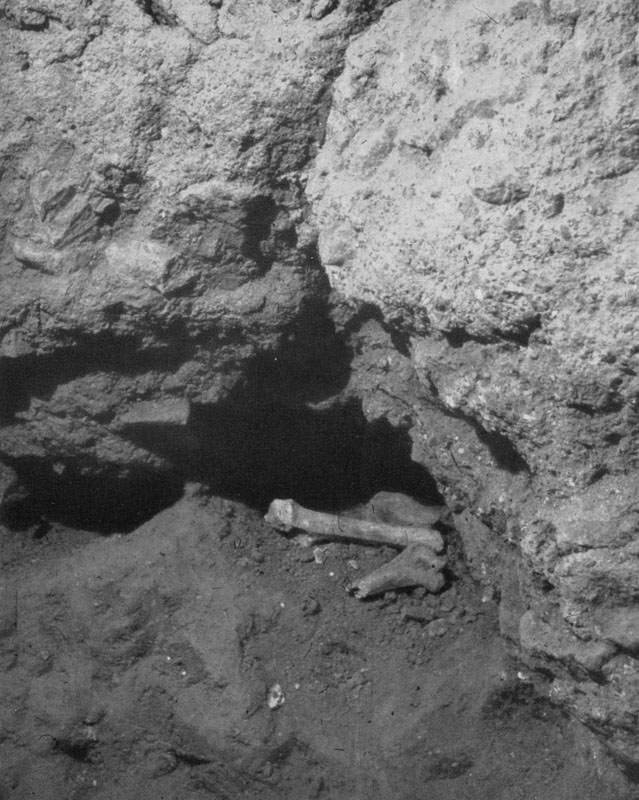
The bones found beneath the Red Wall (briefly replaced there for the photograph). (Fabbrica di San Pietro)
The bones the Vatican archaeologists had discovered in 1942, in the niche at the foundation of the Red Wall, to one side of St. Peter’s grave, remained safely locked in lead-lined chests in the private chambers of the pope for over a decade. Only a cursory examination had been given to them by the pope’s private physician, who declared that they were the bones of a man in his seventies — the age Peter was expected to have been at his martyrdom. The pope had made only a brief, uncertain announcement concerning the bones in 1950. The hungry press, a curious academia, and the anxious Church widely wondered about their authenticity, and the frustration only built at the Vatican’s reticence and characteristic slowness.
Finally, in 1956, at the request of Pope Pius XII, Venerando Correnti, a leading anthropologist and professor at Palermo University, examined the Red Wall bones. Correnti’s meticulous examination and testing took over four years. In the end, his findings were disappointing: these were almost certainly not the bones of Peter. The pile contained the bones of as many as four individuals: two men in their fifties, a man in his forties, and an elderly woman in her seventies, as well as an assortment of animal bones. The animal bones were not a great surprise: the ancient necropolis was known to have been near the emperor Nero’s circus and stables, and discarded animal carcasses may have left their bones strewn all throughout the area.
The bones that had been the objects of hope for over a decade — the bones found in, or at least to the side of, St. Peter’s grave — were not the saint’s relics at all. But that is not the end of the story. Another set of bones had been discovered at the site, that Correnti now prepared to examine.

The Graffiti Wall, on the north side of the Tropaion, showing the repository. (Fabbrica di San Pietro)
Unknown to the archaeologists at the time, there had been a serious blunder early in the excavation. Early in 1942, when the team had first discovered the Graffiti Wall at the north side of the Tropaion, with its curious marble receptacle slightly exposed, they had initially chosen not to disturb it, wishing to fully photograph and document the valuable graffiti before risking damage to the plaster by reaching into the hole. When they finally did examine it, they found nothing inside but a medieval coin, some bone fragments, and other debris.
But by the time they got to it, the receptacle had already been tampered with. Monsignor Ludwig Kaas, the administrator of St. Peter’s Basilica and nominal head of the investigation, had a habit of inspecting the excavations alone at night after the archaeologists had left. Kaas was not an archaeologist himself, and had little appreciation for proper archaeological procedure. Troubled by possible disrespect to the bones of saints, as unknown graves and bones were uncovered in the course of the investigation and set aside, Kaas would remove these bones and place them respectfully in boxes.

In this diagram of the Niche of the Pallia and the surrounding tomb, the Graffiti Wall is labeled Wall g. (Fabbrica di San Pietro)
Late one night within a couple of days of the Graffiti Wall being exposed, Kaas examined it and its receptacle. He brought with him Giovanni Segoni, one of the foreman of the Sampietrini, the skilled workmen charged with the care of St. Peter’s Basilica, who had been assisting in the excavations. At Kaas’s direction, Segoni widened the hole in the plaster and removed the contents of the repository: a considerable pile of human bones with some shreds of reddish cloth. Segoni placed these in a wooden box, sealed it, and labeled it. The box would remain in a storeroom throughout the remainder of the excavation, unknown to any of the archaeologists.
In 1952, when Dr. Margherita Guarducci was examining the graffiti of the Graffiti Wall, she encountered Segoni by chance. She inquired about the contents of the receptacle and learned that he had emptied it himself, and he led her to the box. Not realizing that the archaeologists were unaware of Kaas’s actions, Guarducci was surprised by the size and extent of the bones, and even more so by what she believed was a failure on the part of the archaeologists to document them and consider their importance. It was not until more than a decade later, when Guarducci discussed the matter with Kirschbaum and the other archaeologists, that all realized what had happened.
But Guarducci placed the neglected bones in the queue for Correnti to examine. Preoccupied for so long with the disarrayed pile of Red Wall bones, Correnti did not get to the Graffiti Wall bones until 1962. Fully expecting this to be another collection of mixed bones, he was surprised by his unexpected findings: they were the remains of one elderly man, between sixty and seventy years old, of sturdy build. There were two other puzzling aspects: the bones were encrusted with soil in their crevices and hollows, as if buried and exhumed; and a number of the larger bones appeared to have been stained with a reddish or purplish dye, the color of the shreds of fabric discovered in the box. Sometime after the decay of the flesh, the bones had been dug up from a grave and wrapped in a purplish cloth.
It was Guarducci who, learning of Correnti’s findings, developed the theory that the Graffiti Wall bones might be the bones of St. Peter himself. But why would Peter’s bones be in the marble repository of the Graffiti Wall, and not in the central grave? What was the purpose of the repository? It might have been, Guarducci reasoned, a hiding place, a container for the bones’ safekeeping and protection from Roman persecutors and vandals. At the time of the Graffiti Wall’s construction in the mid-third century, Christianity was under the most aggressive persecution it had suffered in decades, under the emperors Decius and Valerian. Might the Church have felt the bones were threatened?
A closer examination of the scraps of cloth discovered with the bones brought a stunning revelation: it was a cloth dyed what appeared to be purple, and interwoven with pure gold thread of the finest craftsmanship. The dye used, upon chemical testing, proved to be the authentic Roman purpling agent, reserved for royalty.

A sampling of the bones believed to be those of St. Peter. These are the carpals and metacarpals of the left hand. (Fabbrica di San Pietro)
And the dirt encrusted on the bones — could it reveal where the bones had been before? Testing the soil composition of the central grave, the outer courtyard, and the area around the Graffiti Wall, the soil on the bones was a perfect match for the soil in the central grave, quite distinct from the soil in the other locations. These bones appeared to have been at one time buried in the central grave.
But hadn’t the repository been opened in the Middle Ages, as evidenced by the medieval coin discovered inside? A careful disassembly of the Graffiti Wall by the archaeologists revealed that the receptacle had in fact been intact since its construction, and was only cracked open by the archaeologists’ recent excavations (with sledgehammers). While taking it apart, a number of other coins fell out from the wall’s crevices; they reasoned that the medieval coin had fallen into the repository through these cracks. The remains of a dead mouse were also discovered inside, who must have entered somehow — verifying the possibility that small items might have entered the repository without breaching it.
Another fact that had been overlooked, seemingly irrelevant when the repository was thought to have been empty: the fragment of the Red Wall bearing the “Petros eni” (“Peter is inside”) inscription had been discovered inside the repository, jarred loose from a position on the Red Wall where the Graffiti Wall met it and covered it. Perhaps the placement of the inscription was related to the repository. Perhaps, in fact, the words had been hastily scratched just as the wall was being sealed with the bones inside.
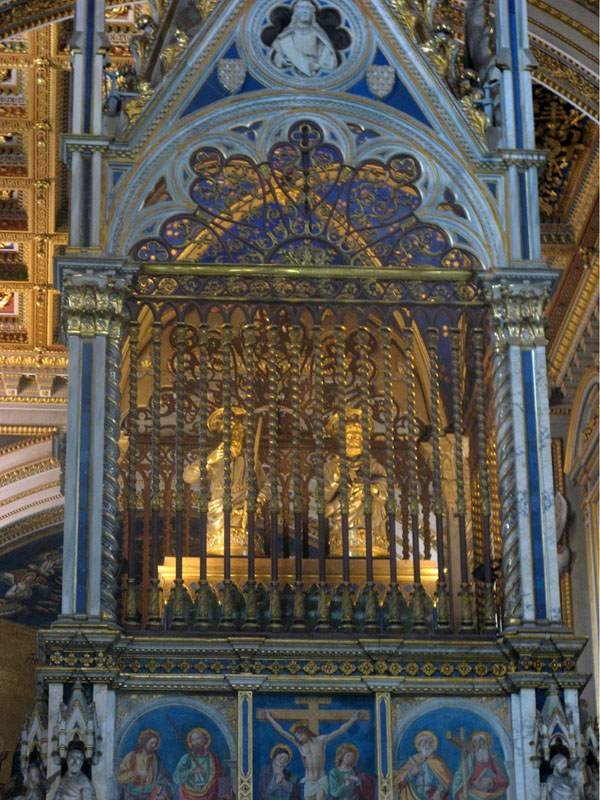
The reliquaries in the ciborium of St. John Lateran, of the heads of St. Peter (right) and St. Paul (left).
And what of the other relics held by the Church to belong to St. Peter? The Basilica of St. John Lateran holds in its reliquaries what are believed to be the heads of Peter and Paul. The last time the Lateran reliquaries had been opened was 1804, when it was observed that only fragments remained of the heads. At least one fragment of a skull had been found with the Graffiti Wall bones — would this conflict with the remains of the Lateran skull? With the permission of Pope Paul VI, the Lateran reliquary was opened and Correnti was allowed to examine its contents. The one condition was that he could not report detailed information about the Lateran relic, for the sake of its veneration; he could only state whether or not it in any way conflicted with or contradicted the Graffiti Wall bones. After several months of careful study, Correnti announced unequivocally that the two sets of bones were consistent with each other.
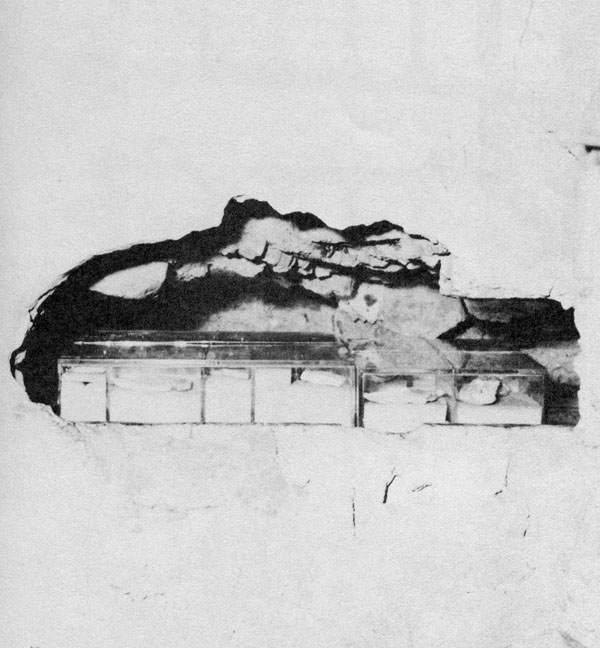
The supposed relics of St. Peter returned to their repository in the Graffiti Wall. (Fabbrica di San Pietro)
On June 26, 1968, Pope Paul announced to the world that the relics of St. Peter had been discovered and identified. Not every question had been answered, but the pope himself was convinced. When all examinations were complete, the researchers carefully placed the bones in nineteen clear, padded plastic containers, and with a brief ceremony, returned them to their resting place in marble repository of the Graffiti Wall.
My feelings about whether these Graffiti Wall bones are the true relics of St. Peter have been wavering back and forth. Some points for consideration:
- This is almost certainly St. Peter’s grave (see my reasoning). At the time the Church turned the tomb over to Constantine, its leaders clearly believed the grave was intact and the relics still there, as did Constantine himself. But why weren’t these bones in the grave itself? If the Graffiti Wall bones are Peter’s, did the leaders of the fourth century Church remember they were there?
- The Graffiti Wall repository was built for a reason, and apparently built to be hidden. If not a hiding place for Peter’s bones, then whose? Other people had been buried close to Peter — but who else might have warranted a burial in Peter’s Tropaion itself?
- Following the decay of the flesh from these bones, the bones had been exhumed from the earth, as evidenced by the earth encrusted on them. They were then wrapped with a purple cloth, as shown by the dye stains on the bones themselves. Clearly these bones were transferred from their original grave and placed in the wall repository. And the earth on the bones is consistent with the earth of the central grave.
- The cloth that wrapped the bones was sumptuous, of the richest royal purple and interwoven with delicate gold thread. It is doubtless these bones belonged to a greatly venerated individual.
- The Graffiti Wall and its repository are believed to have been constructed in the mid-third century, probably the decade between 250 and 260. The repository was then sealed, and not exposed until the excavations of the 1940s. So these bones must belong to someone who died in the first three centuries. No carbon dating was performed on the bones out of a reluctance to destroy any piece of the relics, and a decision that it would not reveal any more precise date than could be reckoned by the above logic.
- The “Petros eni” fragment was in the section of the Red Wall that was covered up by the Graffiti Wall and its repository. Could the marking refer to the resository — Peter is inside here? Was it marked as the wall was being sealed?
- The bones belong to an elderly male, probably between the ages of sixty and seventy, of a sturdy build. This is consistent with the facts known of St. Peter, who is believed to have been martyred between 63 and 67.
- The surviving skeleton, including a fragment of the skull and jawbone, were deemed not to conflict in any way with the skull and jaw fragments believed to reside in the Lateran reliquary.
- Also very curiously, every part of the skeleton is represented by the bones but the feet, which are both absent in their entirety. Conceivably this could be a product of Peter having been crucified upside down: for an easy and hasty removal from the cross, the body might have been hacked off above the ankle.
- At the time Constantine built his memoria encasing the tomb and St. Peter’s Basilica around it, he chose to preserve it exactly as it was, including the asymmetrical and unaesthetic Graffiti Wall, which forced the memoria to be slightly lopsided in shape (and the Niche of the Pallia continues to be to this day). Why was this part of the monument kept despite its unattractiveness? Did the Church insist on its retention, knowing it contained the relics?
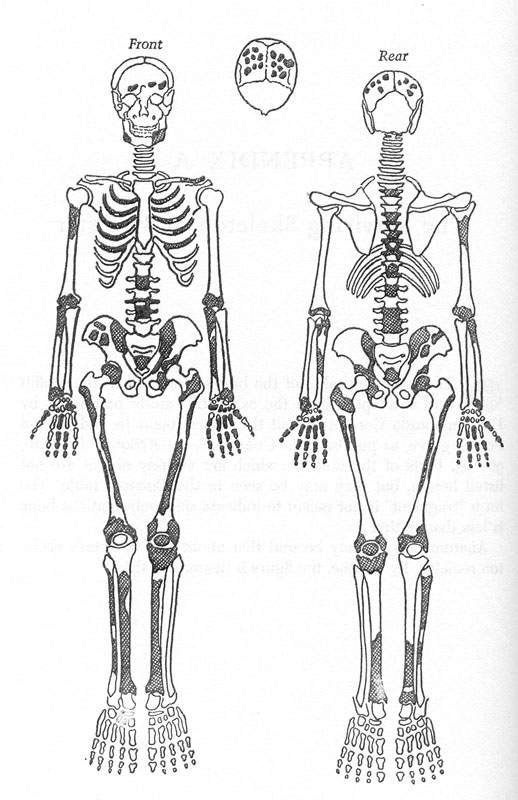
The surviving parts (shaded) of the skeleton believed to be St. Peter’s. Anatomically, about one half of the skeleton survives; by volume, about one third. (Walsh)
At the moment, I’m leaning toward these bones being the genuine relics of St. Peter. This certainly isn’t a conclusive case. It, like so much, has to be a matter of faith for the faithful — and it’s certainly not an essential point of faith for anyone. I am reassured by the thought that this is certainly the grave of Peter, in which his earthly body decayed, and in which his dust lies, whether these are his bones or not. The magnificent church of St. Peter’s Basilica, the central church of Roman Catholic Christianity, if not all of Christendom, stands over the grave of the Prince of Apostles.
Bibliography
Books
- Walsh, John Evangelist. The Bones of St. Peter. New York: Doubleday, 1982. The first book I read on the subject. A riveting and detailed narrative and great introduction to the excavations and to the question of Peter’s bones, and the most up-to-date publication. Full text available online (but missing many of the helpful diagrams, I think).
- Kirschbaum, Engelbert, S.J. The Tombs of St. Peter and St. Paul. New York: St. Martin’s Press, 1959. A more detailed and technical account of the excavations by one of the leading excavators himself. More satisfying and informative from a technical standpoint than Walsh, which helped me in some questions I still had in visualizing the excavation.
- Toynbee, Jocelyn, and John Ward Perkins. The Shrine of St. Peter, and the Vatican Excavations. New York: Pantheon, 1957. I’ve just started reading this one. But Toynbee and Ward Perkins are two very well-known names in both history and archaeology, and this book is frequently referenced in the other two books. I understand that they, as outsiders, had a more critical approach to the excavations.
- Margherita Guarducci. The Tomb of St Peter. Hawthorn Books, 1960. I haven’t read this one yet, but I look forward to Guarducci’s account. It’s also available online.
Websites
- StPetersBasilica.org. A wonderful resource for all aspects of the basilica, including the basilica itself, Grottoes and Scavi. It is the closest one can come to exploring this magnificent church without visiting it oneself. [2014/05/12: This site is now down. I have changed all relevant links to archives of the site in the Internet Archive.]
- Ayerbe, Carolina. “Is it really the Tomb of Saint Peter under Saint Peter’s Basilica?” TheHolidaze.com. 17 April 2012. An outstanding blog post that I found early in my own explorations of the Scavi. Both of the videos she posted were extremely helpful to me in visualizing the evolution of the grave.
- Vatican Necropolis under St. Peter’s Basilica: Virtual Pilgrimage to the Tomb of St. Peter. A virtual walkthrough of the Scavi, ending at the tomb itself. I enjoyed it, and it made up in some way for my being unable to go on the Scavi tour when I was in Rome myself. Next time!
There are extensive bibliographies to additional books, articles, and other publications in the books, especially Walsh. In fact, here you go. That should lead you to most everything that’s out there — though it’s possible there have been publications since 1982.

